- The early days
- Arbiter Electronics
- Arbiter, Dallas & CBS
- Version 1
- Version 2
- Version 3
- Version 4
- Boxes
- Germanium transistors
- Silicon transistors
- Enclosures
- Graphics
- Knobs
- Footswitches
Part 1: History
The early days
Ivor Arbiter was born in Balham, south London, in December 1929.1 His father, Joe Arbiter, was a professional saxophone and clarinet player with Harry Roy’s dance band.2
In 1943, by the age of 14, Ivor Arbiter was working as an apprentice for Barney Lubelle, who ran the Saxophone Shop on Soho Street. By the time he was 16, Arbiter had set up his own instrument repair shop in the basement of a barber’s on Kingley Street. Over the next few years, Arbiter’s small business moved around various locations of Soho, including on Frith Street and Shaftesbury Avenue.3 4
Ivor’s father, Joe, reportedly retired from playing music professionally in 1956, and it was at this point that Ivor decided to run his instrument repair business together with Joe out of their own commercial space (described as a “small room”) above a shop on 76 Shaftesbury Avenue.5 Arbiter traded under the name Paramount, in reference to Paramount Court, where the family lived.6 To be precise, the earliest known formal business venture of Ivor’s was called Paramount Repairs, based at 76 Shaftesbury Avenue.7
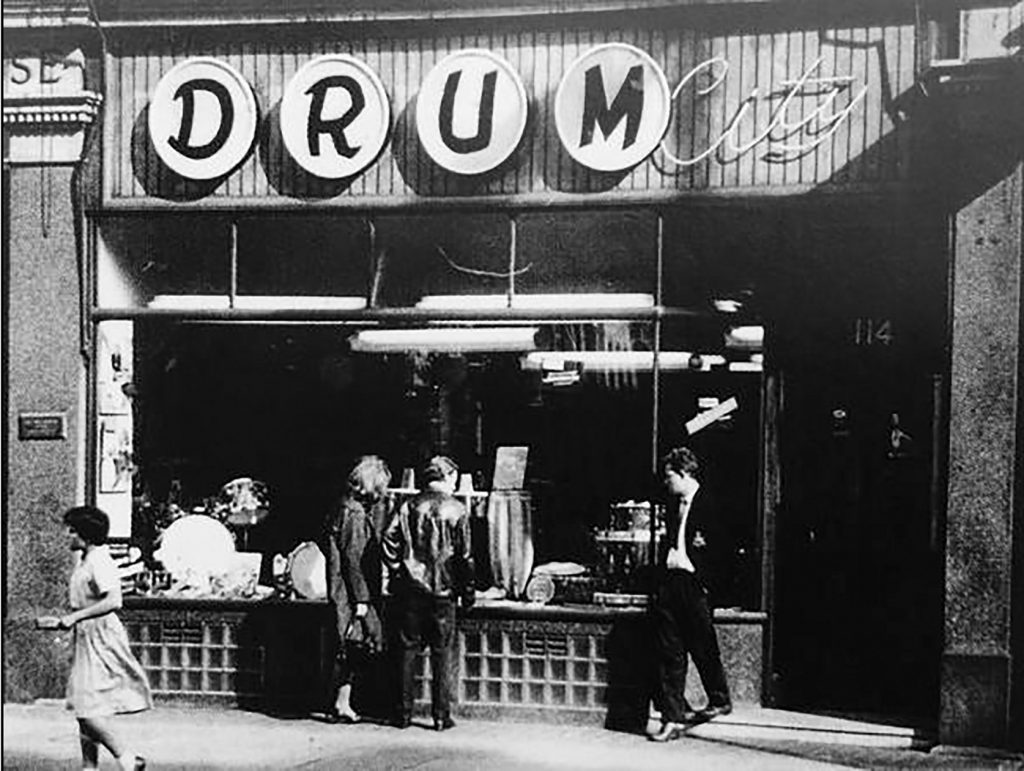
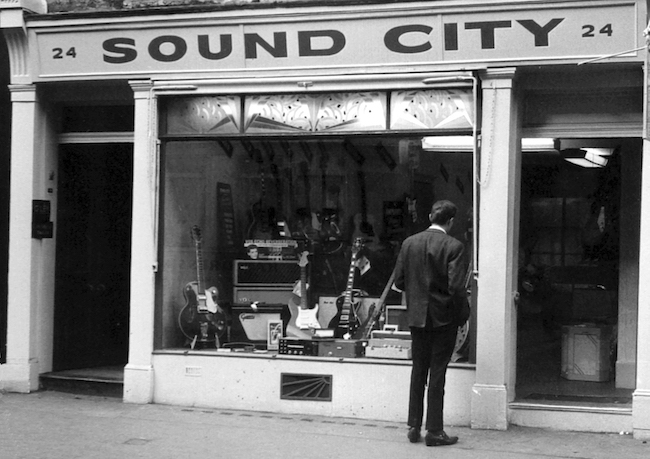
At some point in the early part of 1957, Ivor Arbiter expanded the business through the acquisition of the shop downstairs, and Paramount Musical Instrument Co. began selling instruments (including drums and guitars) from 74/76 Shaftesbury Avenue.8 This would mark the beginning of Ivor Arbiter’s career selling musical instruments. During the early 1960s, Joe Arbiter had passed away, and Ivor Arbiter’s retail business had become so successful that he had expanded to two further shops in Soho: Drum City on 114 Shaftesbury Avenue and Sound City on 22 Rupert Street (pictured above).9 It was around this time that Ivor reportedly designed the Beatles’ famous ‘drop-t’ logo.10
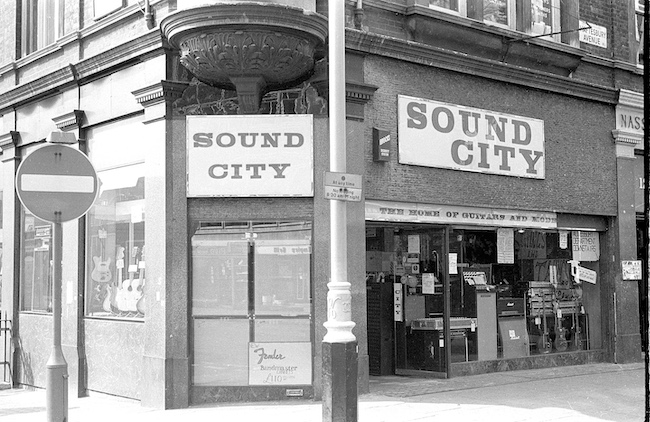

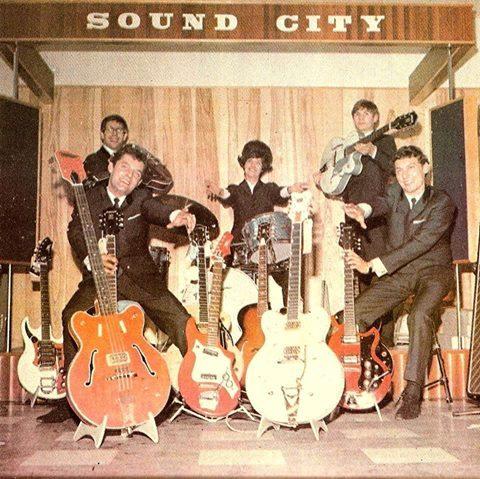
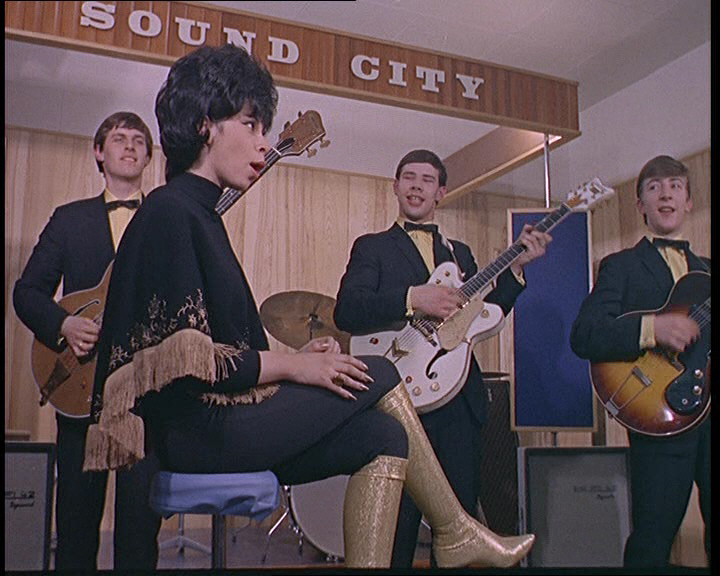
The most famous Sound City shop on 124 Shaftesbury Avenue, pictured above, opened in March 1964.11 Arbiter’s Sound City store on Shaftesbury Avenue would continue to operate through the 1960s and into the 1970s.
Arbiter Electronics
By the mid-60s, Arbiter had set up its own factory and was manufacturing musical instruments and accessories at 33 Woodthorpe Road, Ashford, Middlesex.12 In 1966, the famous Arbiter Fuzz Face was developed, and it was first presented at the British Musical Instrument Industries trade fair held in August of that year.13 Date codes on the potentiometers of surviving examples suggest that production was only properly ramped up by September of that year, because units with pot codes earlier than September are particularly uncommon. The Fuzz Face was already available in the shops by November 1966, when Jimi Hendrix was photographed performing with one.14

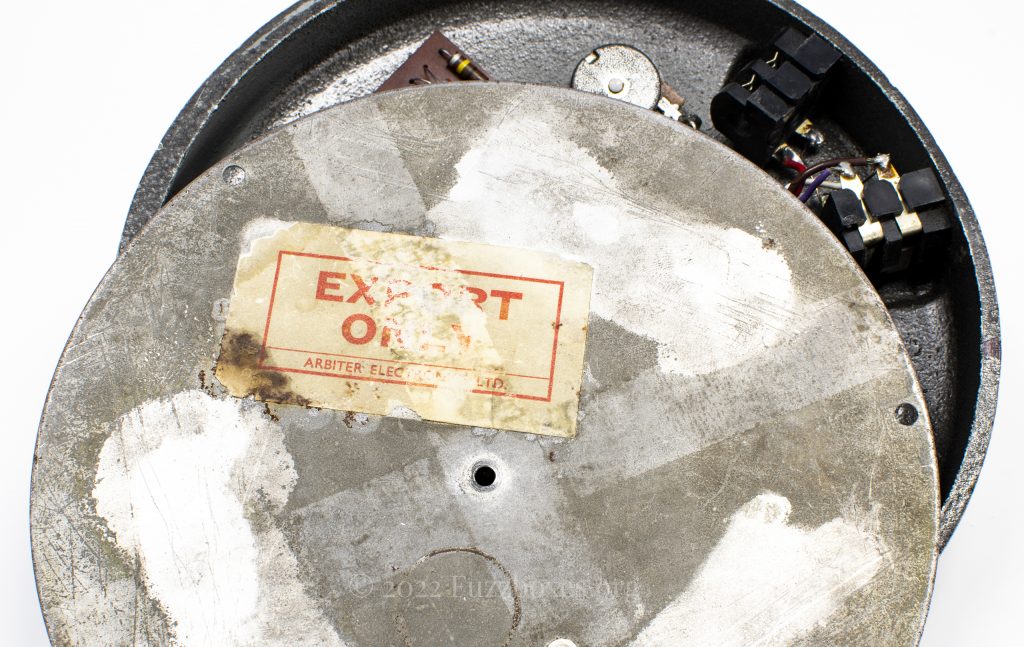
Arbiter clearly had high expectations for the Fuzz Face because they were advertising the model to American retailers as early as in November 196615 and even the earliest Fuzz Faces dating to 1966-1967 resurface outside the UK more or less as often as they do at home. Pictured above is the bottom plate from a 1966-1967 Arbiter Fuzz Face that was unearthed in Sweden, and that still has its original factory ‘export’ sticker intact.
Production of the Fuzz Face in the UK by Arbiter (and Dallas) lasted until the mid-1970s, before moving to the USA in the late 1970s. The manufacturing rights also changed hands a number of times, and the Fuzz Face continued being offered by various different companies to guitarists during the 1980s and 1990s (even briefly including Arbiter once again). More than half a century after its inception, the Fuzz Face remains a hugely popular fuzz box, largely in part due to its association with Jimi Hendrix. Fuzz Faces are still manufactured more or less to the original schematic to this day, and are now sold around the world by Dunlop Manufacturing Inc.
Arbiter, Dallas and CBS
During the 1960s and 1970s, the Arbiter company went through various phases of merging back and forth with other companies, and consequently the Fuzz Faces ended up being branded by a number of different outfits. These included J & I Arbiter Ltd., CBS/Arbiter, Dallas Music Industries, and most famously Dallas-Arbiter. It is important to note at this point that the Fuzz Face was first and foremost an Arbiter product.
J. & I. Arbiter & Dallas Music Limited were apparently still two distinct organisations when they demonstrated their respective products at separate booths, at the March 1968 Musikmesse trade fair. In April 1968, however, it was reported that Arbiter had recently merged with Dallas.16 The merger of these two companies was reflected in the branding of the Fuzz Face, and from 1968 until the mid-1970s, these Arbiter pedals were rebranded as products by ‘Dallas-Arbiter · England’.
Things became much more complicated by the mid-1970s. Ivor Arbiter held a major stake in Dallas-Arbiter, but experienced a “clash of personalities” and felt “disenchanted” and ending up pulling out of the company.17 By 1974, Arbiter signed to become a European dealer of Fender products (which, by then, was taken over by CBS), and CBS/Arbiter was formed.18 During this period of around 1974-1975, the Fuzz Face branding was changed to reflect Arbiter’s new outfit, and it went from being a Dallas-Arbiter Fuzz Face to a CBS/Arbiter Fuzz Face.
Meanwhile, Dallas, who had acquired the rights to the Vox brand a few years earlier, sought to revive the famous amplifier company, and in 1974, Tom Jennings was re-appointed to run his old company under the Dallas umbrella. Manufacturing of the new Vox equipment took place at Dallas’ new factory in Shoeburyness, Essex, but Dallas would soon fall into financial difficulty. Coming full circle, Dallas was acquired by CBS/Arbiter, and consequently the last of the Fuzz Faces built in the UK (c. 1975-1976) were branded Dallas Music Industries.19
Despite all of Arbiter’s corporate reshuffling, over the course of the decade that Fuzz Faces were being manufactured, the Fuzz Face’s design went virtually unchanged.
As a side note, the merge between Arbiter and Dallas in 1968 was not the first time that Dallas was involved in selling fuzz boxes. Around the same time in 1966 that Arbiter unveiled the Fuzz Face, Dallas was also being supplied by Sola Sound with Rangemaster Fuzzbug pedals. These Fuzzbugs were nothing more than rebranded Sola Sound Tone Benders, but because some earlier Fuzzbugs used the two-transistor ‘MK1.5’ Tone Bender circuit that Arbiter based the Fuzz Face on, the Fuzzbug has been incorrectly speculated by some as being evidence of a direct link between Dallas and Arbiter as early as in 1966.
At the time of writing, however, there is no evidence to actually support this theory. Dallas was simply among a larger number of companies that were supplied by Sola Sound with rebranded fuzz boxes, and the Fuzz Face was developed specifically by Arbiter, roughly two years before the two companies merged. Anecdotal evidence behind the single known two-transistor Dallas Fuzzbug pedal even reveals that it was originally sold at Macari’s Musical Exchange,20 which would have been a competitor of Arbiter’s retail outlets in London at the time.
Part 2: Overview
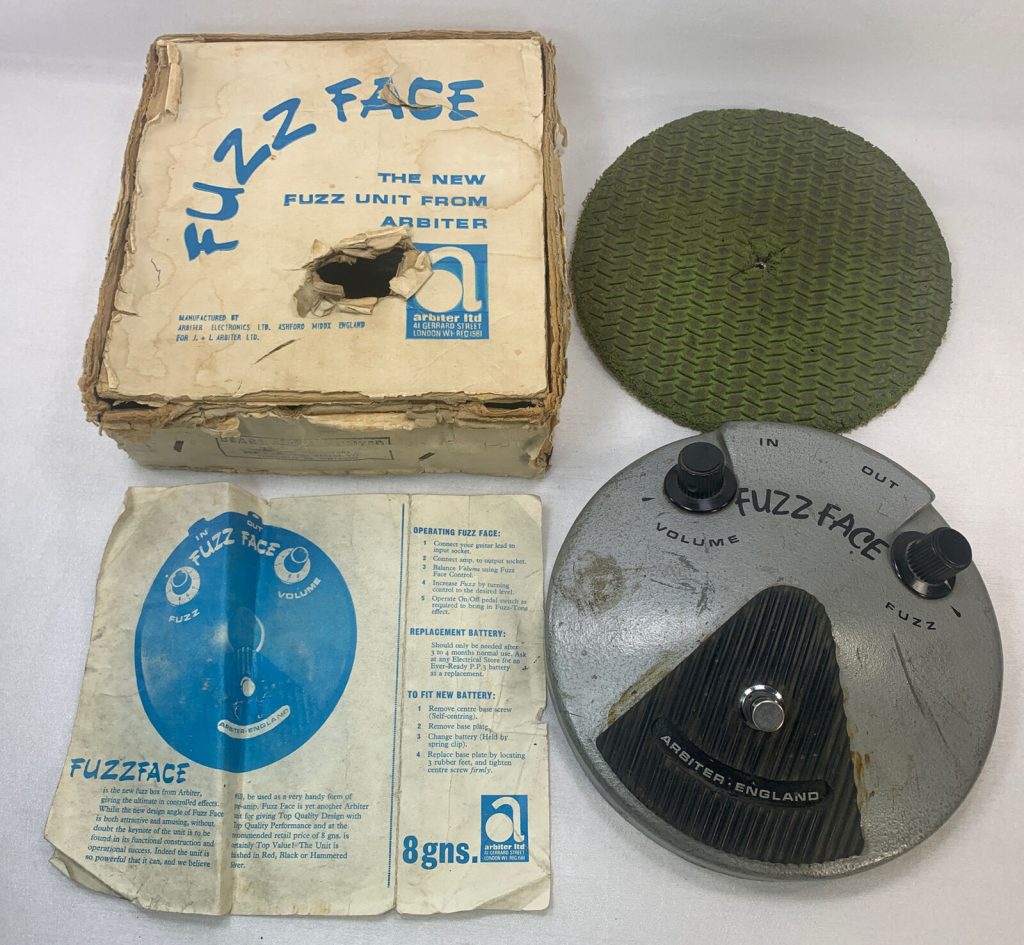
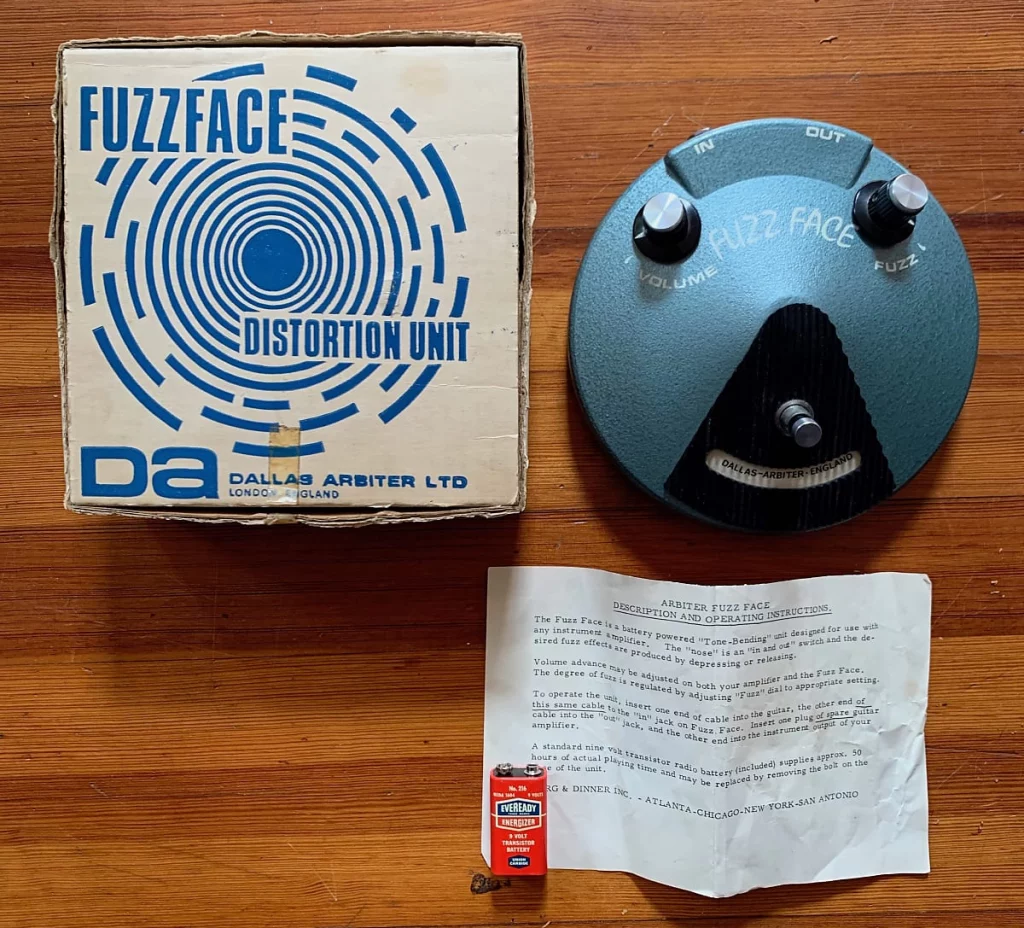
The Fuzz Face was incredibly simple in its operation. It was powered by a single 9-volt (PP3) battery, and like most of the other early fuzz boxes on the market, it was fitted with a basic on/off switch and two control knobs to set the volume and intensity of the fuzz effect.
Fuzz Faces were built into cast aluminium enclosures, and they were fitted with a steel bottom plate that enabled users to access the circuitry inside, and obviously also to replace the batteries. These bottom plates were fixed in place by a single (imperial 4BA) screw threaded down the centre of the pedal. Aligning the screw, bottom plate and the enclosure was awkward, and so Arbiter supplied earlier pedals with a tube to make changing batteries easier.
A distinctive feature that set the Fuzz Face apart from its contemporaries was the shape of its enclosure, and the cartoonish layout of the controls, rubber ‘beard’ and Arbiter ‘smile’. Up until this point, early fuzz boxes typically came in utilitarian square and wedge-shaped housings. The round shape of the Fuzz Face was reportedly inspired by the base of a microphone stand.21
Another unusual marketing strategy deployed by Arbiter all the way from the Fuzz Face’s inception in 1966, until production in the UK ceased in the 1970s, was offering customers a choice of Fuzz Faces in different colours. The earliest Fuzz Faces were built red, black and hammered silver enclosures, but as time went on, Arbiter were selling various different kinds of blue and grey pedals as well.
After production of the British-built Fuzz Face was discontinued, there was a period in the late 1970s when Dallas Music Industries (DMI) manufactured pedals in the United States. The model then lay dormant until Crest Audio (a subsidiary of DMI) started building Fuzz Faces again in the mid-1980s,22 and this was soon followed by Jim Dunlop’s reproductions, which are widely sold around the world to this day.
It has become common knowledge that earlier Fuzz Faces were built using germanium transistors, and that, after a few years, Arbiter redesigned the circuit to accommodate silicon transistors. A lot has been written about the perceived differences in sound quality between the various types of transistors, but in reality, there are a lot of different factors that contribute to the overall tone of a Fuzz Face (including the age and wear of some of the old parts).
Part 3: Analysis
This section goes into detail about the different types of Fuzz Faces built by (Dallas-)Arbiter during the 1960s. For such a simple pedal, there are actually a lot of different variables to look out for when ascertaining a pedal’s originality and date of production. In comparing the vintage Fuzz Faces in this section, references will be made to each pedal’s type of enclosure, the graphics, knobs, switches and the circuit & parts selection. This section also explores how these various features correlate with one another in the wide assortment of Fuzz Faces built by Arbiter over the course of a decade. It is strongly recommended to regularly refer to the glossary at the end of this article.
1966-1967 | Version 1
‘Thick print’ Fuzz Face
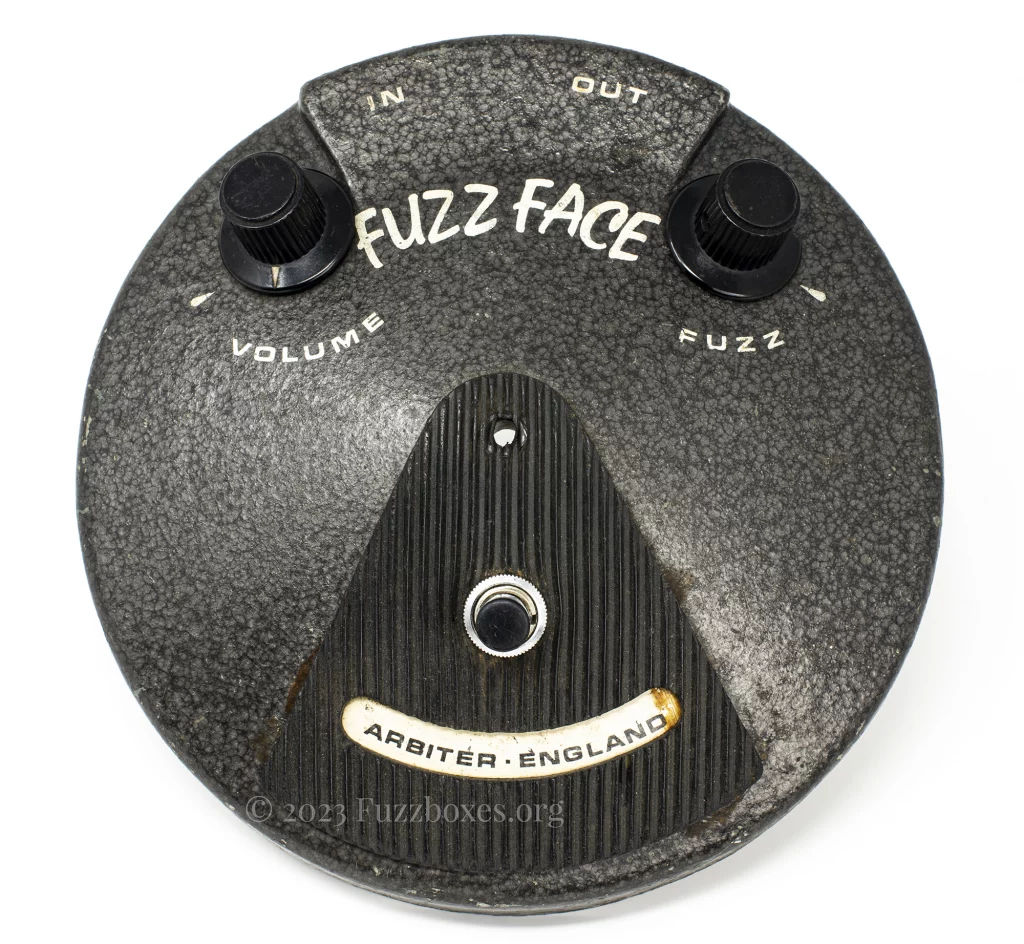
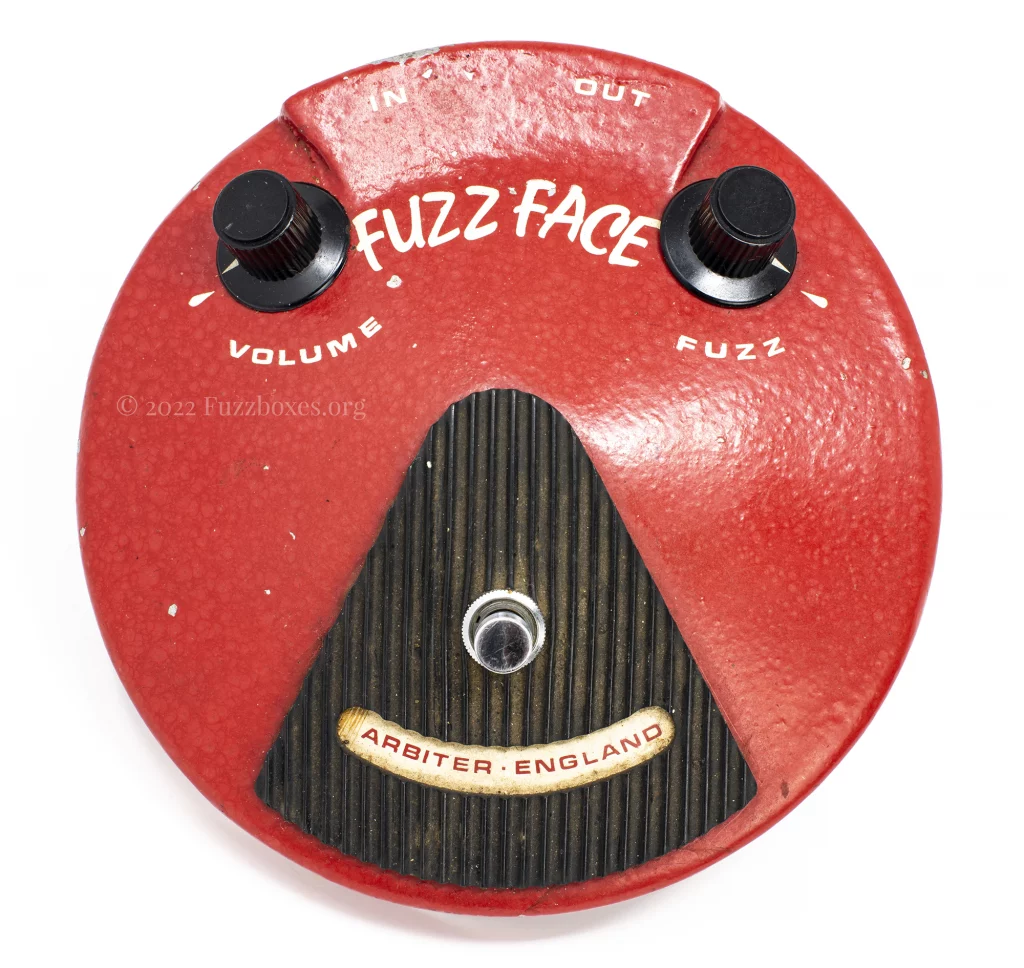
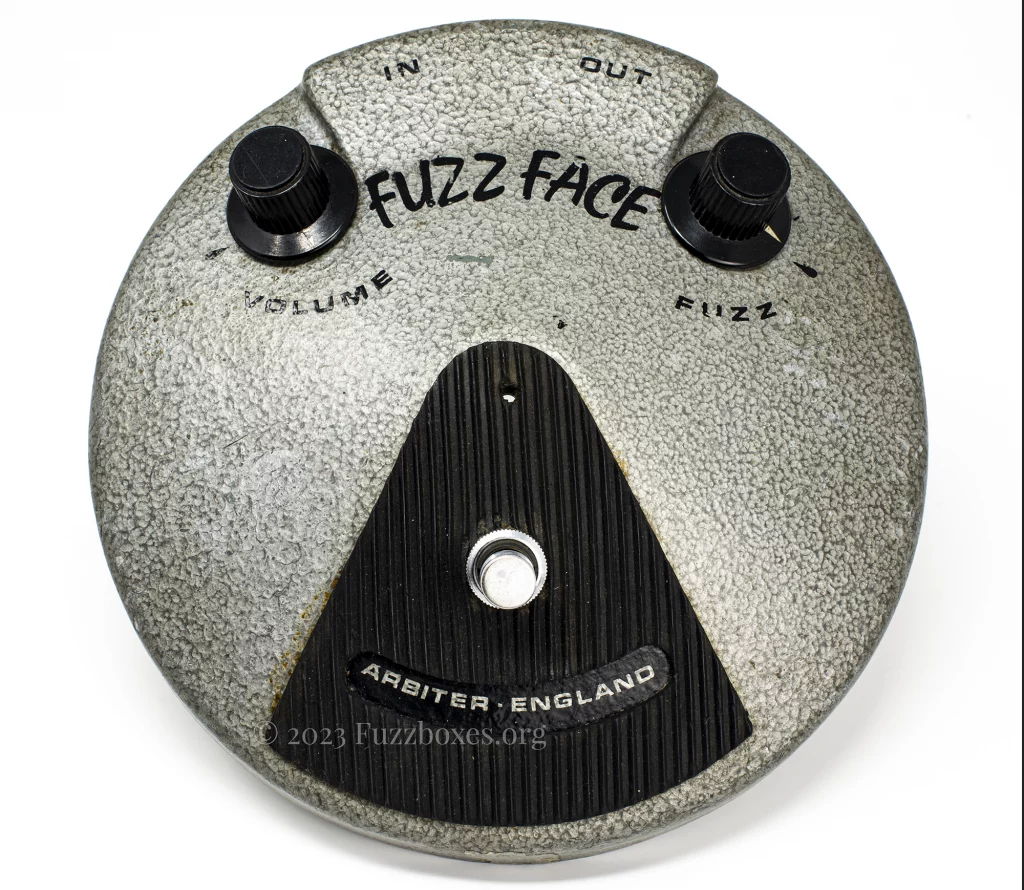
The three pedals pictured here are all early Fuzz Faces, dating to c. 1966-1967. They all have a heavier ‘thick’ version of the Fuzz Face logo, and are housed in Arbiter’s earliest type of cast enclosure. Because of the different graphics, these Fuzz Faces are often deemed by dealers and collectors to be the very first Fuzz Faces. Unfortunately, there isn’t any concrete evidence to support this theory. This is because, while the ‘thick print’ is indeed a feature that only appears on 1966-1967 Fuzz Faces, the three pedals pictured above also have other things in common with later Fuzz Faces. The same logic that is used to make a determination that pedals with one set of graphics must predate another set of graphics can also be applied to observations about schematics and parts selection, and it is therefore impossible at this stage to conclusively place these ‘thick print’ Arbiter Fuzz Faces at the beginning of the timeline.
Key features:
- They have all only ever been sighted with Bulgin ‘top hat’ type knobs, which Arbiter continued to use on certain versions of the Fuzz Face until the early 1970s
- When unmodified, these pedals always come fitted with Bulgin footswitches that have the moulded plastic inner mechanism, which is also something that appeared on some Fuzz Faces as late as the early 1970s
- They almost always use the ‘conventional’ germanium transistor circuit, with the blue 2.5µF input capacitor (although some exemplars have been sighted with the more uncommon 1.6µF input cap)
‘Thin print’ Fuzz Face
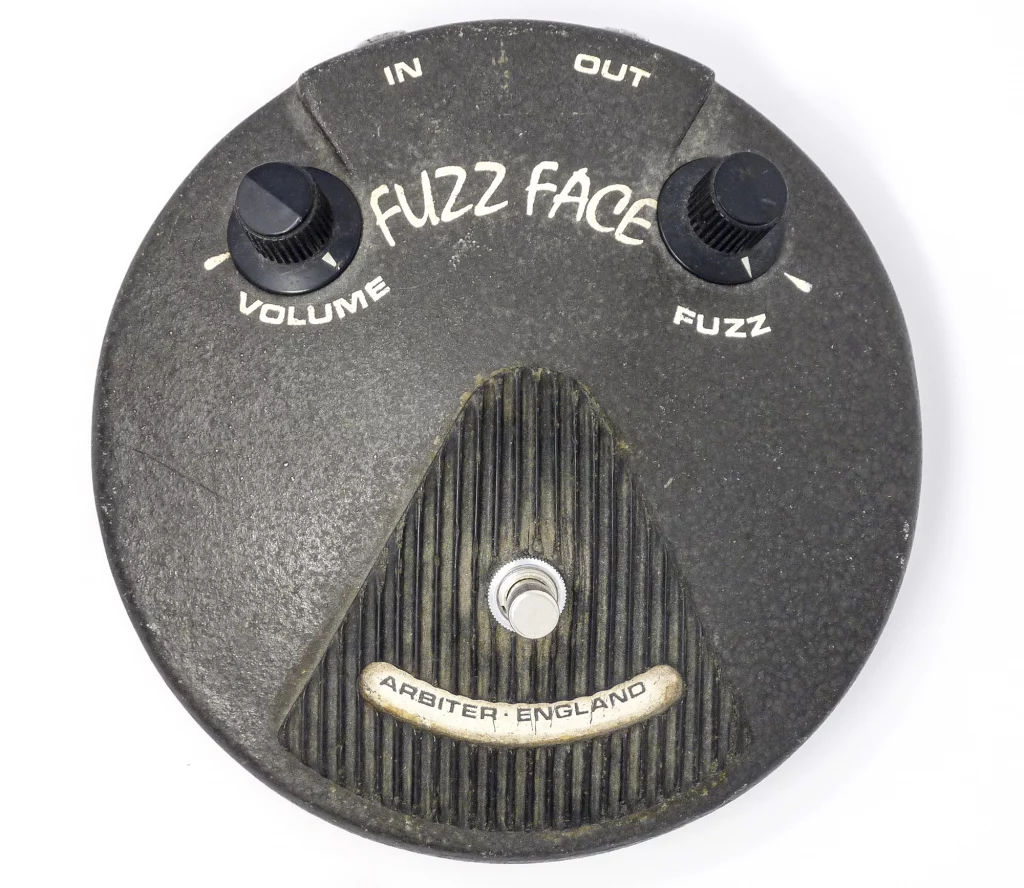
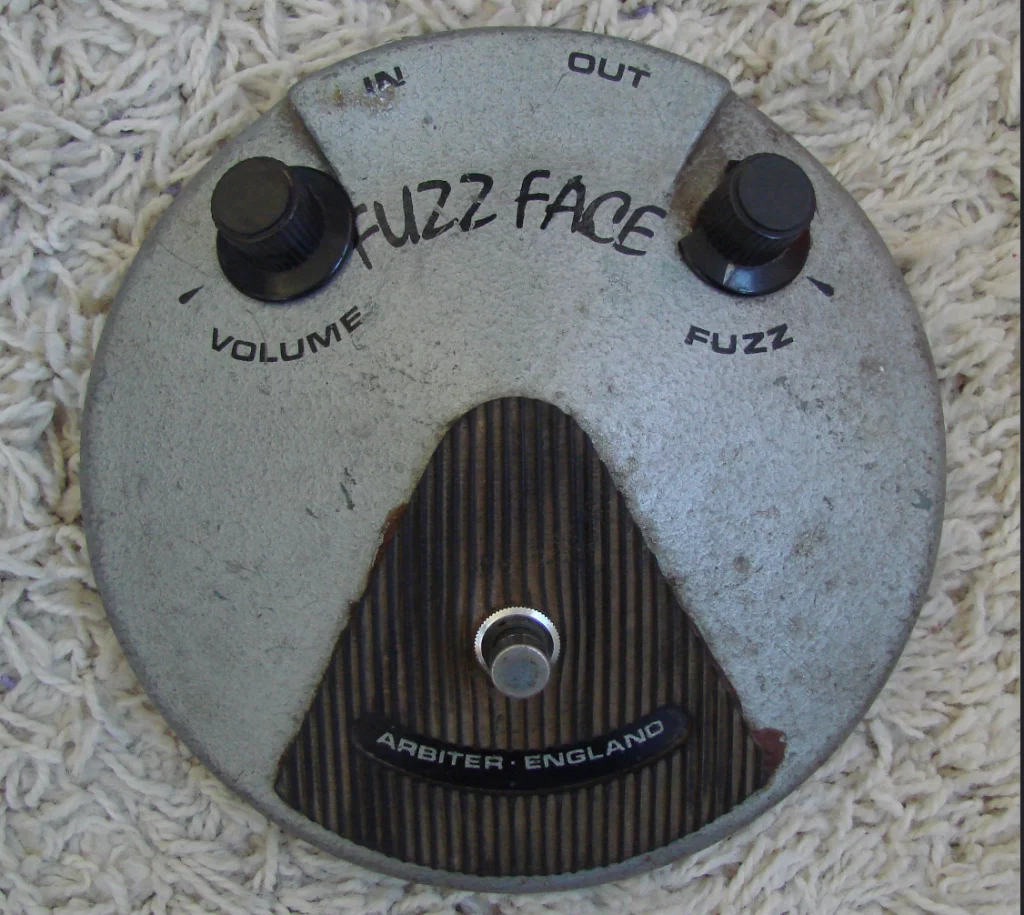
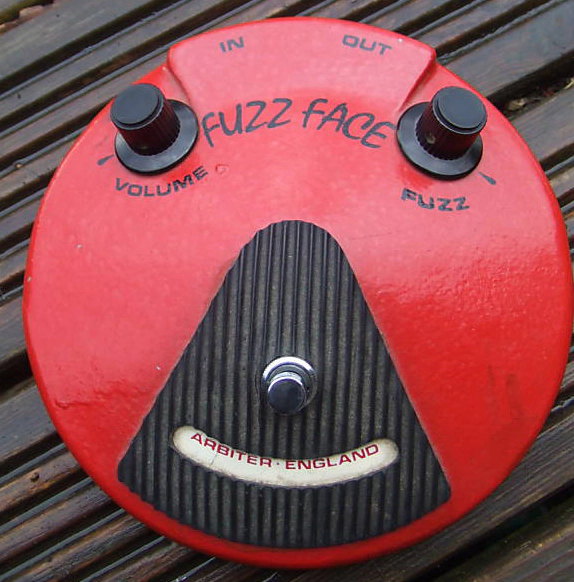
The pedals pictured above are also among the earliest Fuzz Faces. They were all built in the ‘first version’ enclosure, and they all feature the germanium transistor Fuzz Face circuit. In terms of cosmetics, the only thing that sets these Fuzz Faces apart from the 1966-1967 ‘thick print’ Fuzz Face is the more familiar ‘thin’ version of the Fuzz Face logo. This typeface would continue to be used on Arbiter Fuzz Faces through the 1970s, and also for the various modern day official reproduction Fuzz Faces.
Key features:
- Just like the 1966-1967 ‘thick print’ Fuzz Faces, in original condition, these pedals also boasted Bulgin ‘top hat’ knobs and the Bulgin footswitch with the sealed inner mechanism
- The unusual and short-lived 5µF/30µF Marcon electrolytic capacitors have only ever been sighted in this Fuzz Faces with this specific combination of enclosure, font and hardware features
- Other exemplars of this type of 1966-1967 Fuzz Face are commonly sighted with the ‘conventional’ 2.5µF input capacitor, but they occasionally have the 1.6µF input capacitor instead
- The unusual colour combination of red paint with black silkscreened lettering has only ever been sighted on this version and the very similar ‘dial knobs’ version of the Fuzz Face
‘Dial knobs’ Fuzz Face
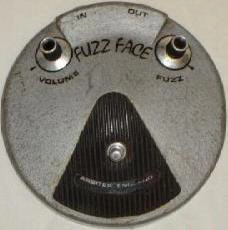
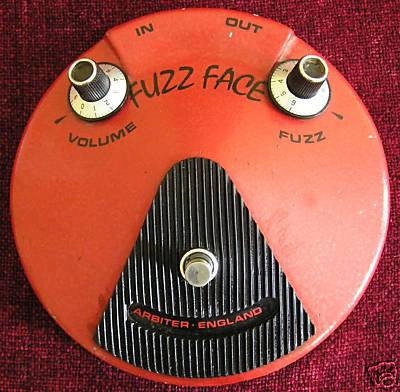
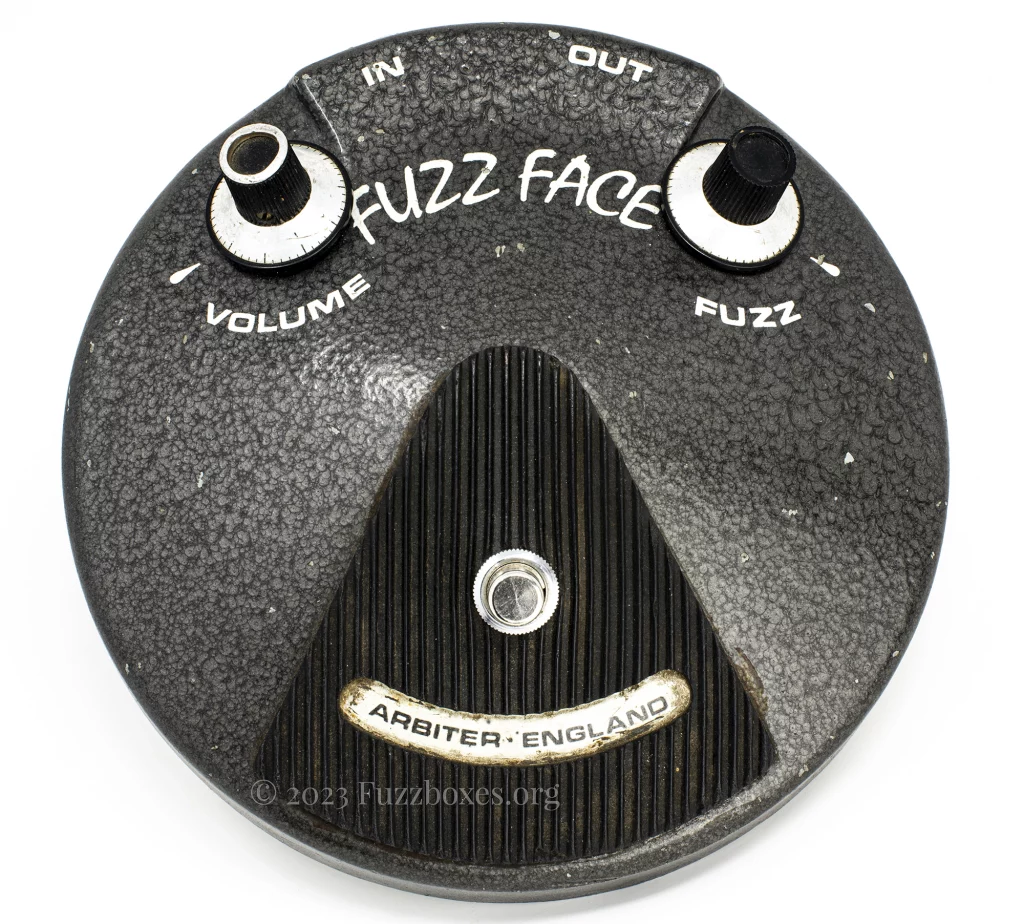
The main visual difference between this early Fuzz Face and the type in the previous section is obviously the type of knobs they were fitted with. These ‘dial’ knobs were seemingly only used by Arbiter for a limited period, but they can also be seen on Arbiter’s late 1960s Treble and Bass Face pedals, as well as some of the Arbiter/Sound City amplifiers. Notably, the ‘dial’ knobs can also be seen on the bizarre Fuzz Face pictured in Arbiter’s very earliest promotional material from 1966.
A small handful of 1966-1967 Fuzz Faces have surfaced bearing Arbiter’s ‘export’ stickers underneath, and these pedals happen to all be the ‘dial knobs’ variant, as pictured here. It’s clear, however, that not all Fuzz Faces with ‘dial’ knobs were built for the export market, because they resurface fairly regularly in the UK too.
Key features:
- When unmodified, Fuzz Faces with the ‘dial’ knobs have only ever been sighted with the earlier ‘wafer’ style Bulgin footswitch
- These pedals have also only ever been seen running the ‘conventional’ 2.5µF input capacitor version of the germanium Fuzz Face circuit
- The earliest known sets of potentiometer date codes in vintage Fuzz Faces (July & August 1966) come from some of these ‘dial knobs’ pedals, but this does not necessarily imply that they were among the very first built — they only show how difficult it is to place all the different 1966-1967 Fuzz Faces into chronological order
- As with the alternative ‘thin print’ 1966-1967 Fuzz Faces with ‘top hat’ knobs, the red pedals with ‘dial’ were also printed with graphics in the unusual black ink
- Use of the ‘dial’ knobs continued into the 1968 ‘version 2’ era of Fuzz Faces, although they’re a lot more uncommon to see
1968-1969 | Version 2
1968 ‘Arbiter · England’

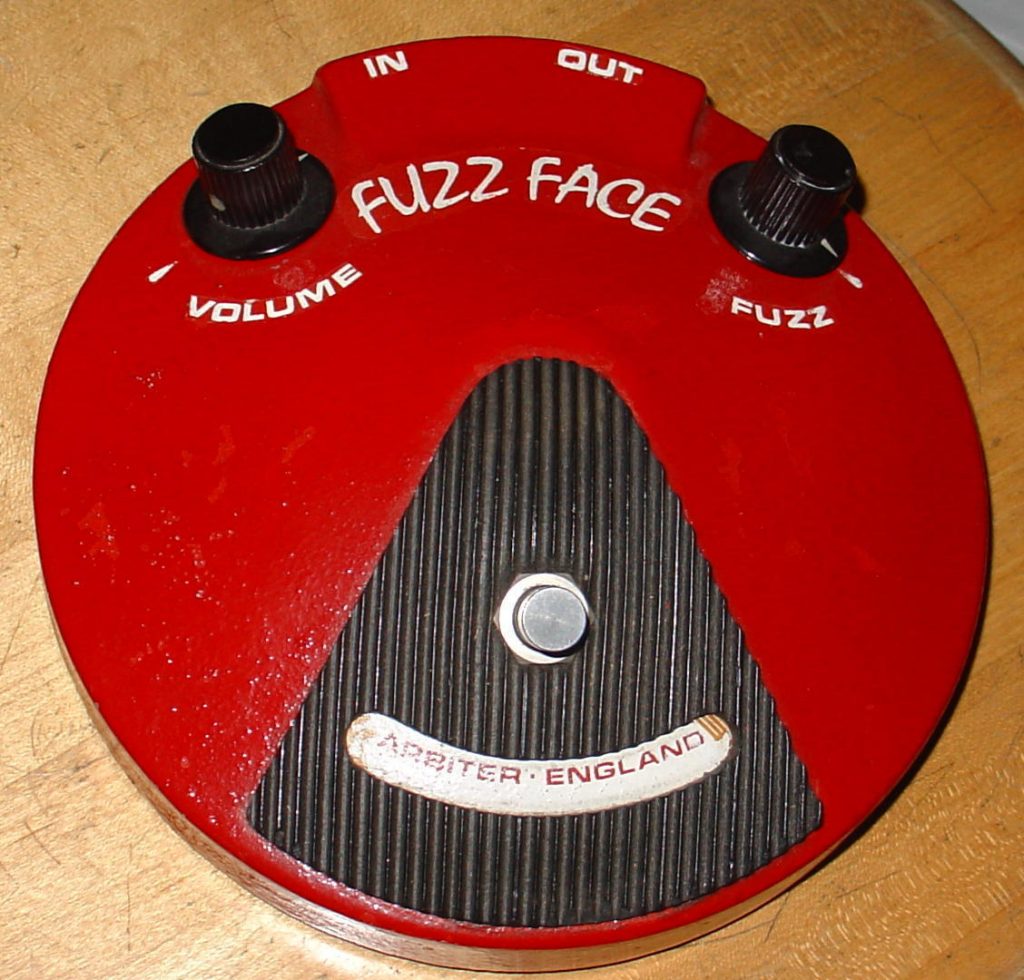
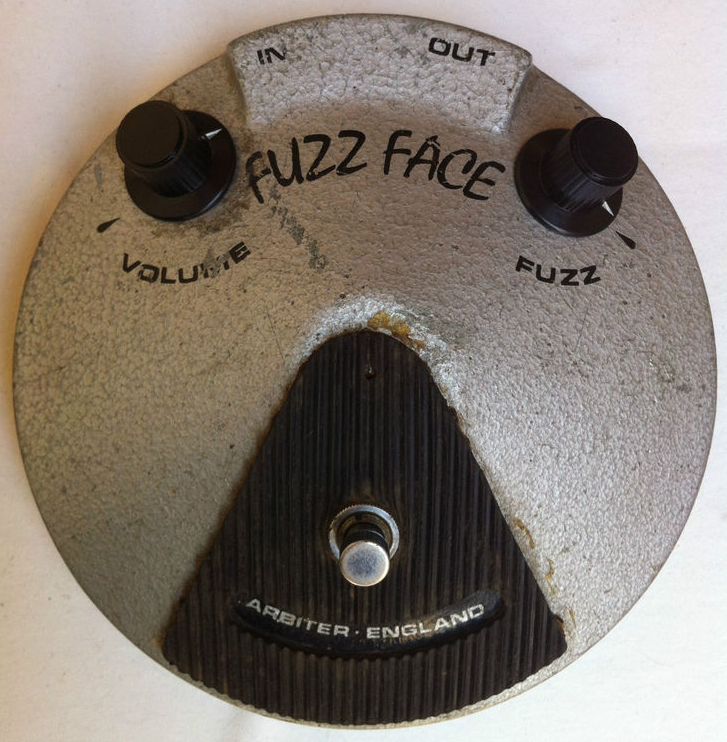
These pedals were all built into the ‘second version’ enclosure. The easiest way to tell these enclosures apart from the earlier 1966-1967 version is by comparing the proportions of the ‘brow’ between the control knobs, where the ‘in’ and ‘out’ labels are printed. On this updated enclosure, the ‘brow’ is noticeably narrower than on the earlier Fuzz Faces, but not so much that the silkscreened graphics on the enclosure had to be changed — ‘second version’ Fuzz Face enclosures like these used identical graphics to the ‘thin print’ 1966-1967 Fuzz Faces.
The three pedals pictured above are all earlier examples of this ‘version 2’ Fuzz Face. Other features that were carried over from the 1966-1967 Fuzz Faces include the use of Bulgin ‘top hat’ knobs, ‘Arbiter · England’ branding (as opposed to the later ‘Dallas-Arbiter’), and of course, the NKT275 germanium transistor circuit. Some of these ‘pre-Dallas’ Fuzz Faces were built using pots from the same parts supply as the 1966-1967 model, but they have also been sighted with pots dating as late as September 1968. Because the Dallas-Arbiter merge happened in Spring of that year,23 and because Arbiter apparently still had a supply of pre-merge enclosures in Autumn, we can quite safely say that these ‘version 2’ Fuzz Faces weren’t built prior to 1968.
Key features:
- Same colour schemes, graphics and ‘Arbiter · England’ branding as the 1966-1967 pedals
- Prior to the merge with Dallas, these Fuzz Faces were only ever built with the NKT275 germanium transistor Fuzz Face circuit (and 2.5µF/20µF input/bypass cap configuration)
- Only the Bulgin switch with the moulded plastic mechanism has ever been sighted in these pre-Dallas ‘version 2’ Fuzz Faces
- A small handful of these ‘pre-Dallas’ 1968 Fuzz Faces have also been sighted with the ‘dial’ knobs
1968-1969 ‘Dallas-Arbiter · England’
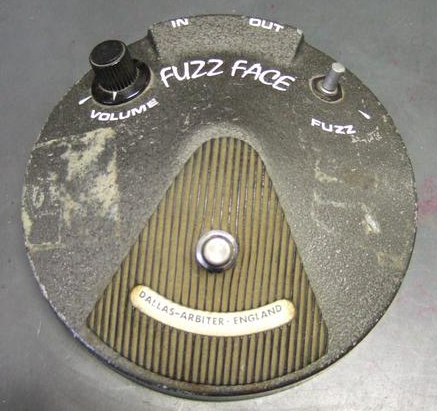
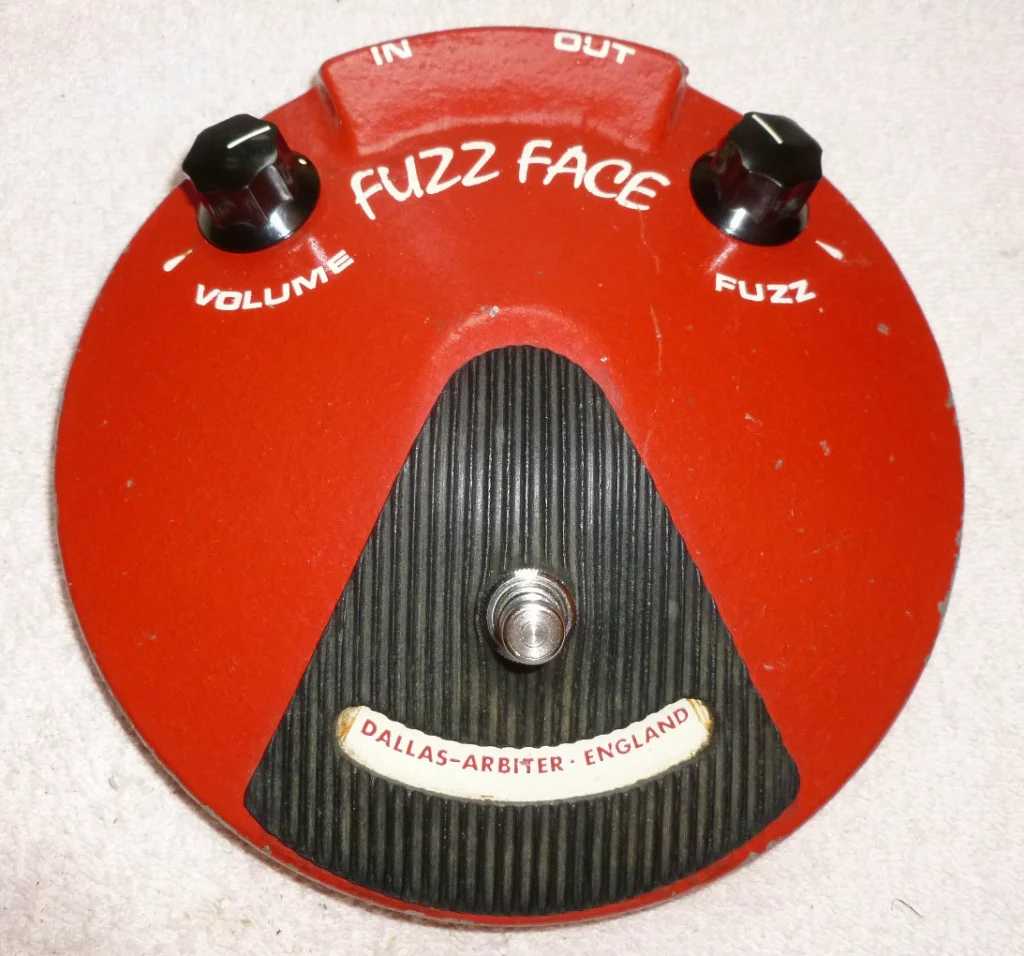
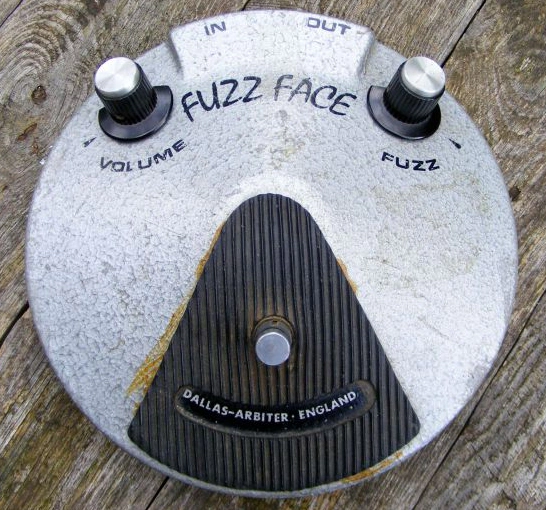
Arbiter seemingly built Fuzz Faces into these enclosures right around the time that the company merged with Dallas, because identical cases have been sighted branded as both ‘Arbiter · England’ and ‘Dallas-Arbiter · England’. Arbiter apparently also restocked potentiometers during the period that this enclosure was in use, as the earlier ‘second version’ (germanium transistor) Fuzz Face pedals still used the same pots dating to late 1966 as all of the ‘first version’ enclosure pedals. Some ‘second version’ Fuzz Faces have even been sighted with a combination of pots stamped with both 1966 and 1968 date codes. Because of this, it is fairly safe to say that Fuzz Faces in the ‘second version’ enclosure weren’t built prior to 1968.
The Arbiter Fuzz Face circuit went through a number of changes during the period when these ‘second version’ enclosures were being used. Many pedals came with the germanium NKT275 Fuzz Face circuit, but it was somewhere around late 1968 or early 1969 that Arbiter redesigned the Fuzz Face circuit to work with NPN silicon transistors.
Key features:
- ‘Dallas-Arbiter · England’ Fuzz Faces in this ‘version 2’ enclosure were used for both the silicon and the germanium circuits
- Generally speaking, ‘version 2’ Fuzz Faces with the black ‘top hat’ knobs (sometimes with silver discs on top) featured the NKT275 circuit; Fuzz Faces with the slimmer black knobs featured the BC183L circuit
- For reasons unknown, Dallas-Arbiter appeared to very briefly revisit this ‘second version’ enclosure in the early 1970s, as exemplified by a small handful of unusual BC130C Fuzz Faces (with 1970s-era parts) that have been discovered in these casings
1968-1969 | Version 3
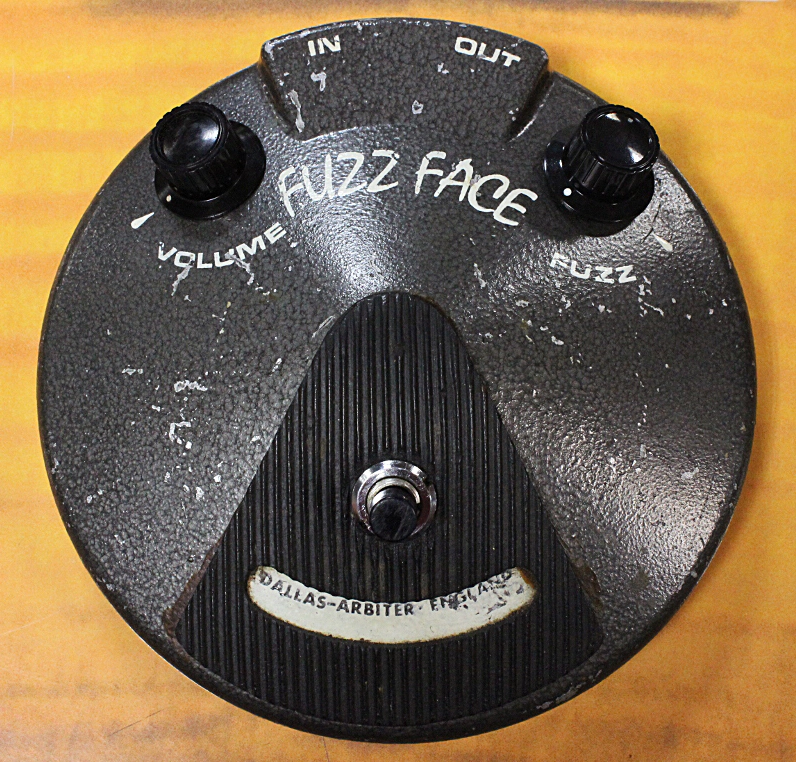
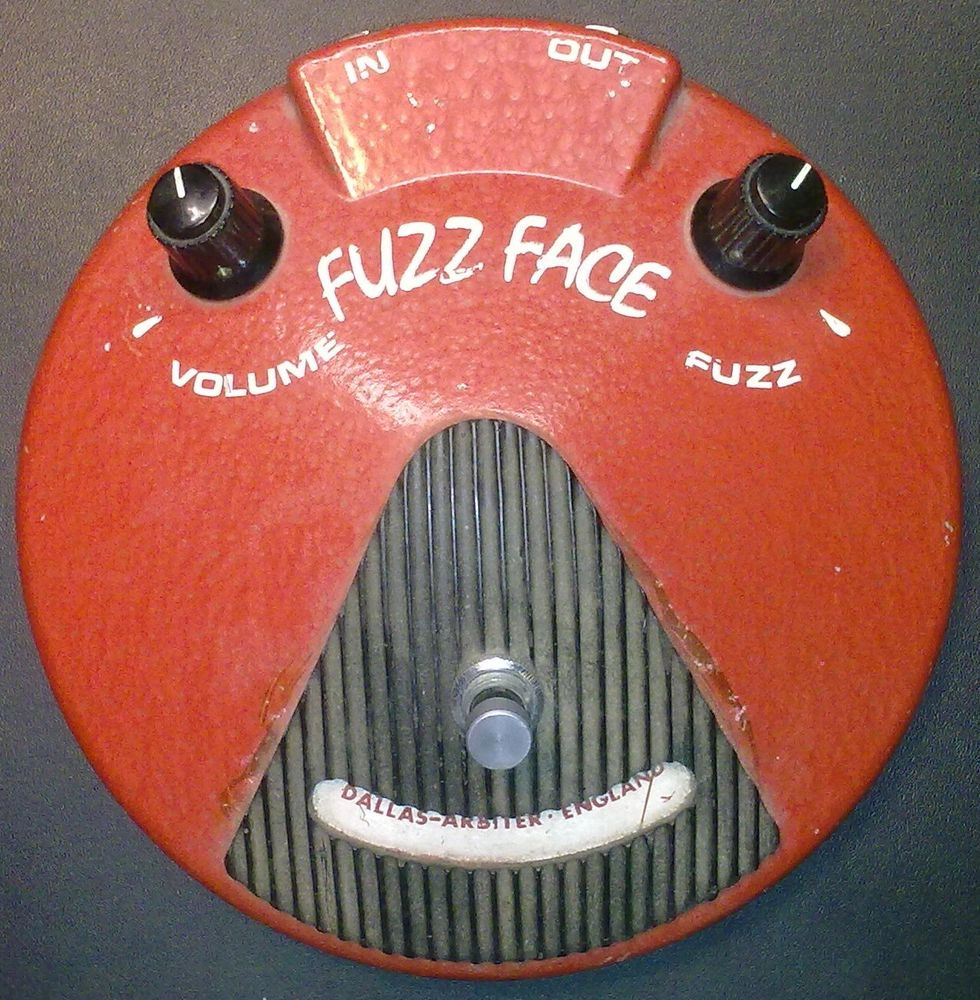
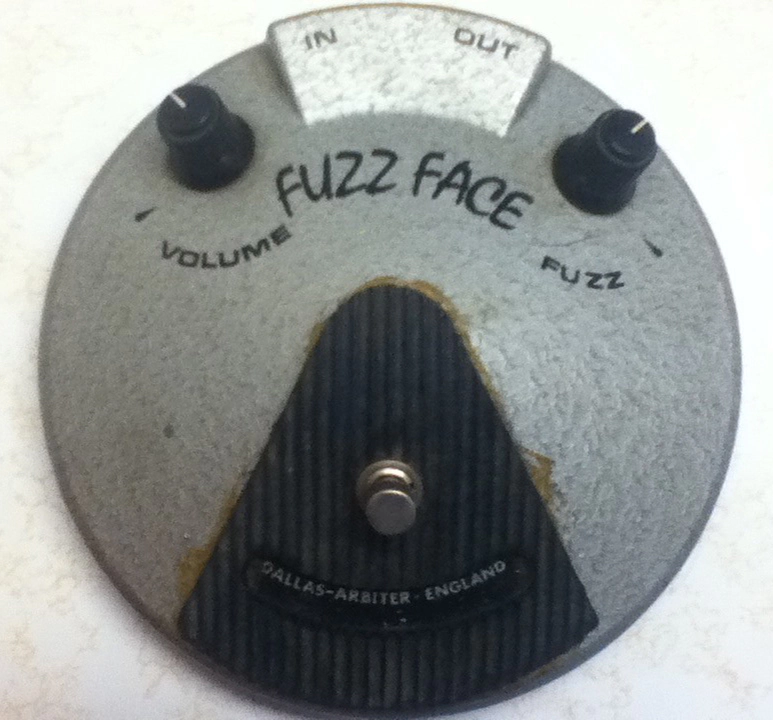
Another version of the Fuzz Face enclosures came with a distinctly narrower middle ‘brow’ between the control knobs. These ‘third version’ enclosures with the narrow ‘brow’ were also used to house Arbiter’s Treble and Bass Face pedals, and this makes placing them into a timeline of Arbiter pedals rather confusing. Treble and Bass Faces housed in this narrow ‘brow’ enclosure have only ever been sighted with (pre-Dallas) Arbiter branding. Fuzz Faces in this type of casing, on the other hand, are only known to exist branded for the post-1968 merged Dallas-Arbiter company.
It is certainly possible that the ‘third version’ enclosures were originally intended for Treble and Bass Faces due to the way that the screen printed Fuzz Face logo doesn’t fit between the ‘volume’ and ‘fuzz’ controls, as per the original (1966-1968) graphics layout. Fuzz Faces in this ‘third version’ enclosure could have been made from Arbiter’s leftover enclosure supply after the Treble and Bass Face was discontinued, but this is entirely speculative.
Regardless of where the ‘narrow brow’ Treble and Bass Faces fit into the wider chronology, the potentiometer date codes for Fuzz Faces housed in this ‘third version’ casing strongly imply that they were built after Fuzz Faces in the ‘second version’ enclosures. Fuzz Faces with the ‘narrow brow’ typically come with potentiometer date codes spanning the period from late 1968 through to mid-1969.
Key features:
- Same three colour schemes as the earlier Fuzz Faces (silver, red and dark grey)
- Built with the BC183L, BC183KA and NKT275 versions of the Fuzz Face circuit (with as late as 1969 date codes)
- Only ever branded for Dallas-Arbiter
- Only ever fitted with the ‘thin’ knobs
1969-1976 | Version 4
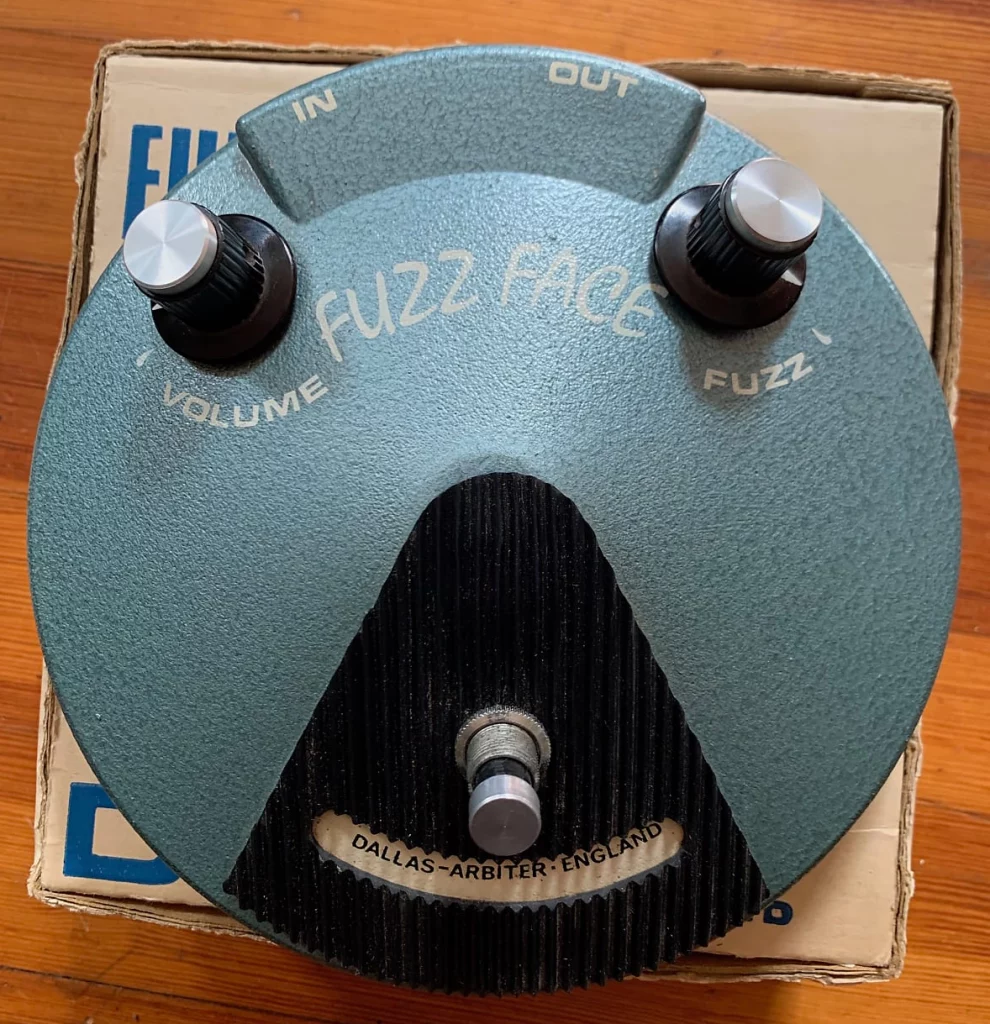
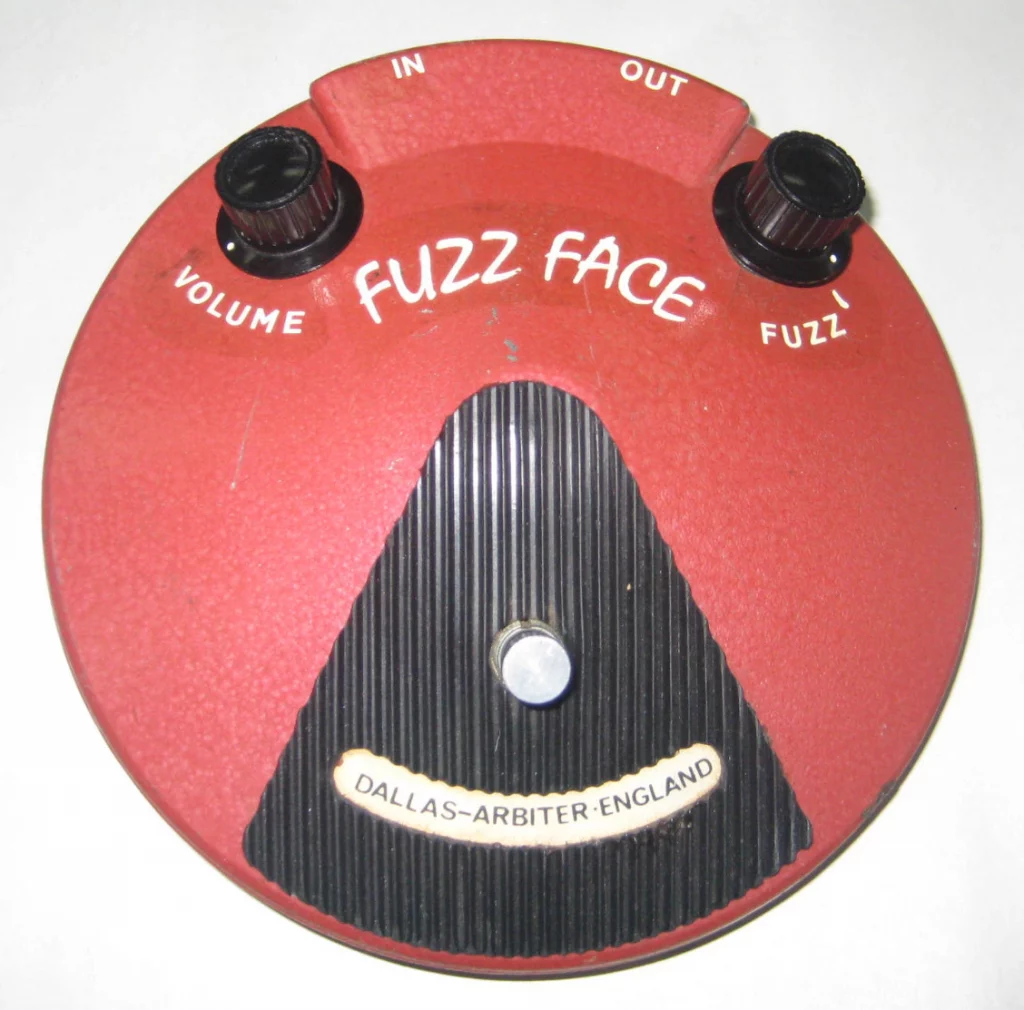
The pedals pictured here were all built into Dallas-Arbiter’s fourth (and final) version of the Fuzz Face enclosure. By the time that Dallas-Arbiter had moved onto this new design, they also increased the range of colour schemes on offer, including various different blue, grey and red paintjobs over time.
The first pedal of the gallery above is the earliest of these ‘version four’ Fuzz Faces — it features a BC183KA transistor circuit, just like the last of the ‘version 3’ pedals, and which is consistent with a pedal built around 1969. Many of these ‘version 4’ Fuzz Faces came with the same Bulgin ‘top hat’ knobs that Arbiter first used back in 1966. By 1972 (ascertained from potentiometer date codes), Dallas-Arbiter had moved onto using a different type of round knob for the Fuzz Faces, similar to the type famously used on Orange amplifiers at the time. The second pedal pictured in the gallery above features those ‘Orange’ style knobs, along with a BC108C circuit.
Dallas-Arbiter continued using the same silkscreened graphics as the ‘version three’ Fuzz Faces on these newer enclosures. At some point during the early 1970s, however, the company started applying the lettering to Fuzz Face enclosures with decals instead. The second pedal in the gallery above is an example of a Fuzz Face with the decal graphics — note the faint outline around the lettering that was left from the process of transferring the decal. Fuzz Faces with these decal graphics were certainly not built until the 1970s, because no pedals with ‘decal’ graphics have been sighted with 1960s potentiometer date codes.
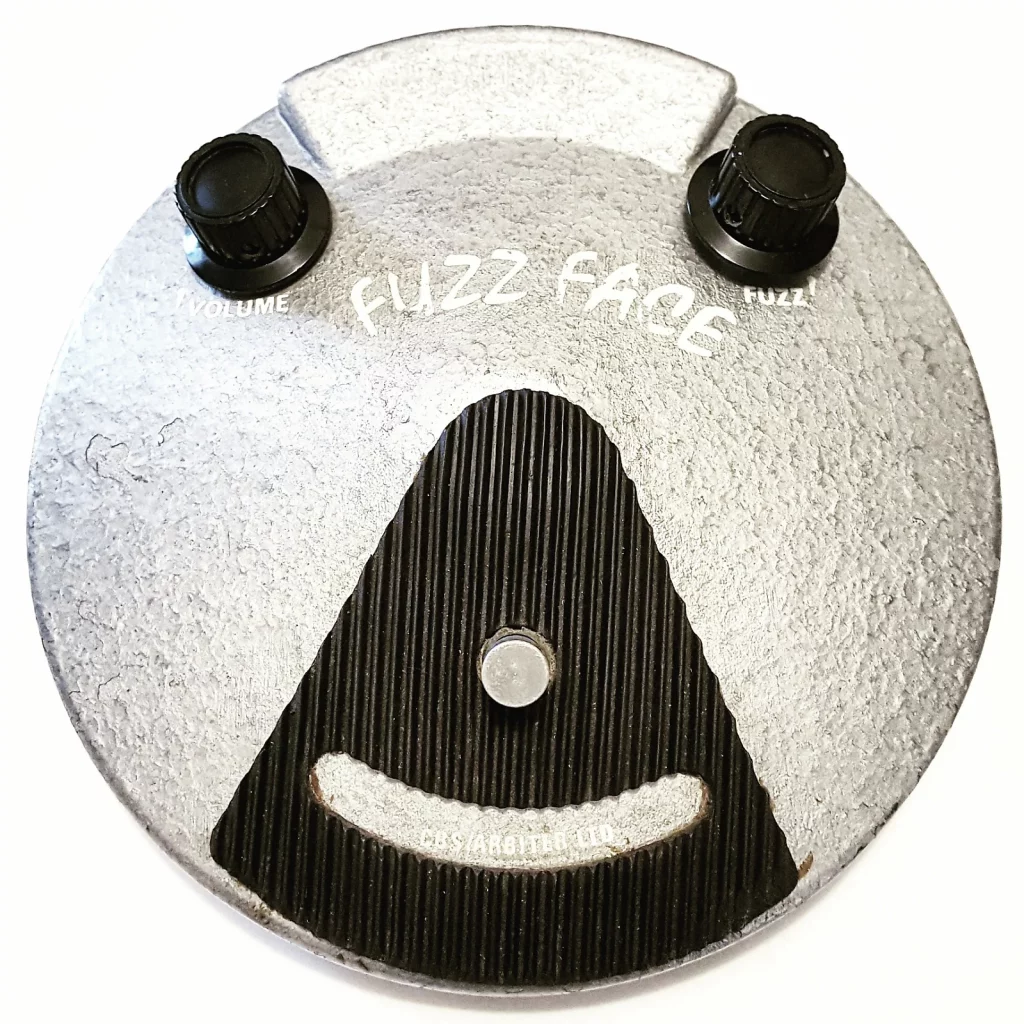
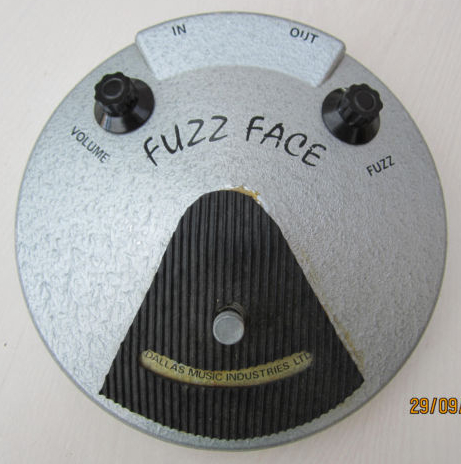
Fuzz Faces continued being built into these ‘version 4’ enclosures, following the dissolution of Dallas-Arbiter, and along with a change in branding on the ‘smile’ of the pedal, these CBS/Arbiter & Dallas Music Industries (DMI) Fuzz Faces also demonstrated changes in graphics and knob types.
Key features:
- Only ever fitted with silicon transistor circuits (BC183KA, BC108C, BC209C, BC239C)
- The earliest ‘version 4’ Fuzz Faces may have been built in 1969, but the overwhelming majority are from the 1970s
- Branded as ‘Dallas-Arbiter’, ‘CBS/Arbiter’, and ‘Dallas Music Industries’, depending on the age
- Early ‘version 4’ Fuzz Faces had Bulgin ‘top hat’ knobs; most built in the 1970s had the ‘Orange’ style knobs; the very last of the British-built (DMI) Fuzz Faces used a flatter skirted Bulgin knob
Part 4: Appendix
Boxes
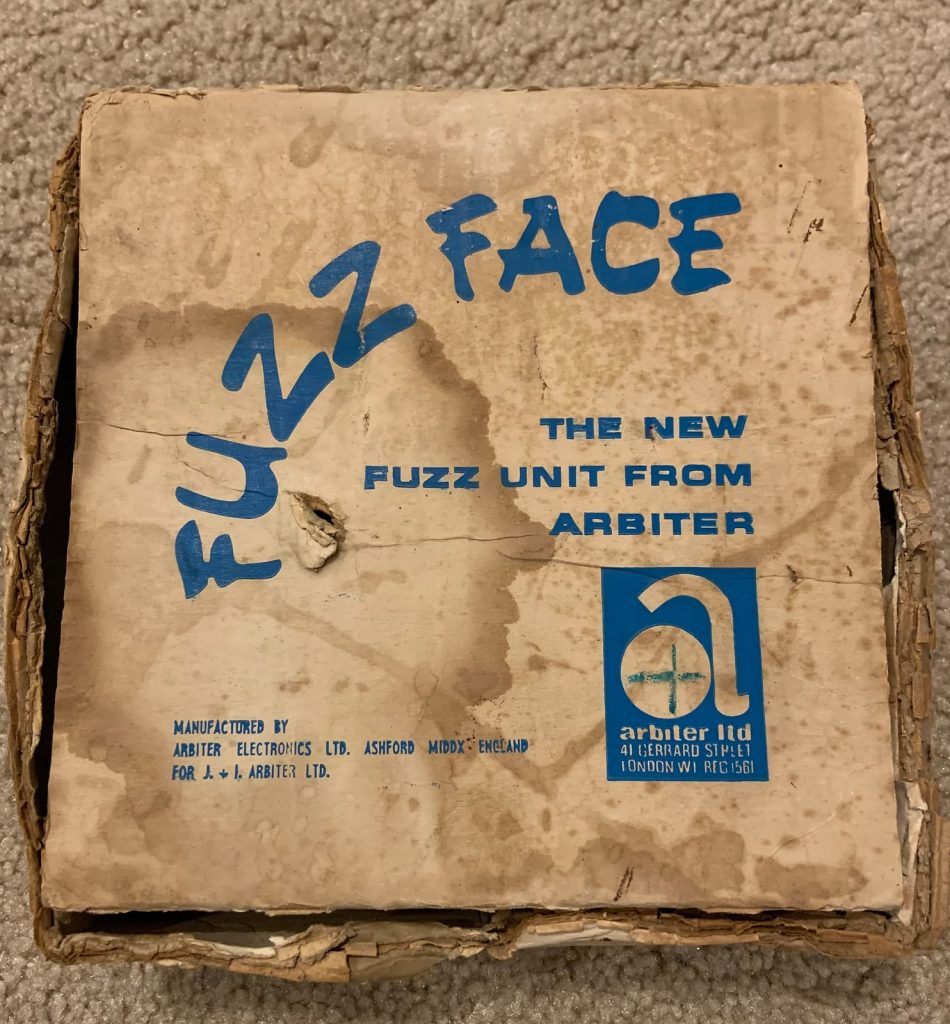
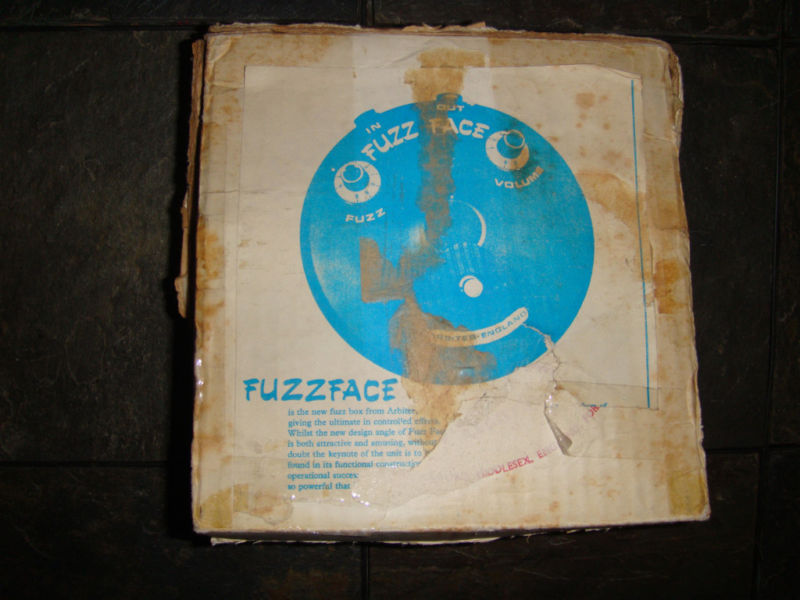
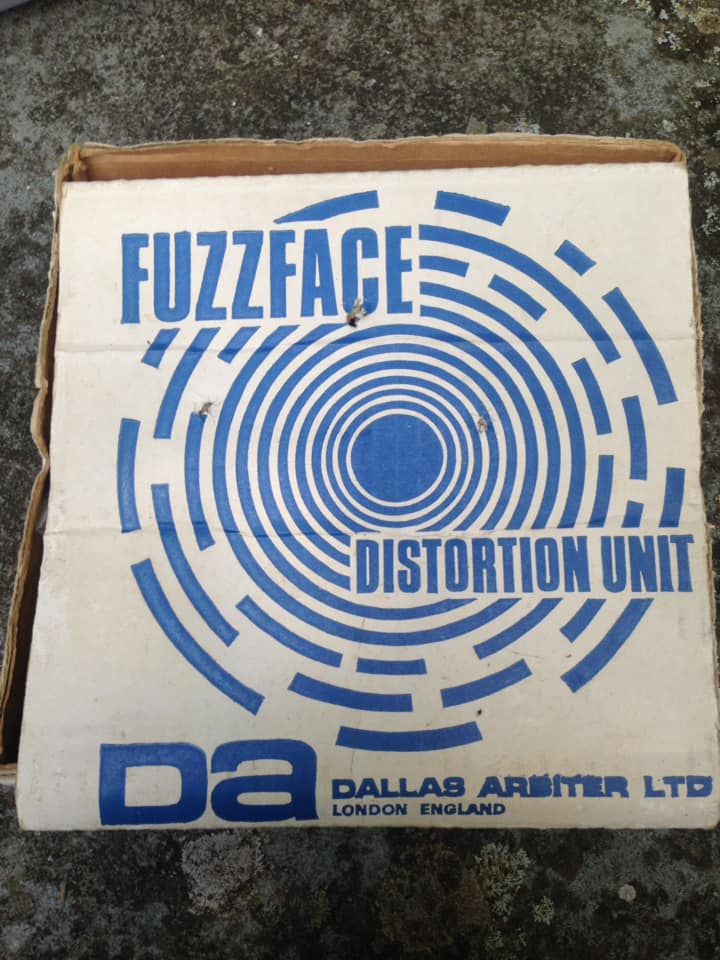
Fuzz Faces were also packaged in a variety of different box designs over the years. A selection of 1960s-era Fuzz Face boxes is pictured above. The first box with the arching ‘Fuzz Face’ lettering is most likely the earliest design, and it has only been sighted together with first generation Fuzz Faces, c. 1966-1967. This particular box design was later reused for the short-lived Arbiter Fuzz Face reissued during the late 1990s.
The second box features a very early promotional photo of the Fuzz Face. The particular pedal photographed by Arbiter for that box has a number of unusual features (such as the typeface, the inverted controls and the enclosure shape), which have not been observed in any extant vintage Fuzz Face. It’s possible that the pedal in this early picture was some sort of prototype or ‘mock-up’, or that it was simply so limited in its production that none are known to have survived. The same photo was used in Arbiter’s advertising and on some of the earliest instructions sheets during the period of around 1966-1967. Interestingly, however, the pedals that have been found together with these boxes thus far all date to the period around late 1967/early 1968.
The third box pictured here, with its swirling psychedelic artwork, was introduced in the late 1960s, possibly to coincide with the formation of ‘Dallas-Arbiter’. These boxes were used to package Fuzz Faces until the dissolution of Dallas-Arbiter in the 1970s, but the design was revived in modern times by Dunlop Manufacturing Inc. for their reissue Fuzz Face pedals.
Germanium transistors
1966-1967 | NKT275
The Fuzz Face circuit features what is commonly described as a “textbook” shunt-series negative feedback amplifier circuit. Rather than drawing inspiration from a textbook, however, the specific mixture of parts values reveal that Arbiter simply copied the circuit from Sola Sound’s 1966 Tone Bender ‘MK1.5’. Arbiter even went as far as describing their pedal as a “Tone-Bending” unit in the instructions sheet that accompanied early Fuzz Faces.
Almost all of the parts values in the early Fuzz Faces match up with the ones in the two-transistor ‘MK1.5’ Tone Benders. The main difference, however, was that Arbiter opted to use [Newmarket] NKT275 PNP transistors instead of Mullard OC75 PNP transistors. The collector of the first transistor was also biased slightly differently in the Fuzz Face.
There have been myths swirling around over the last few decades about Arbiter opting to use AC128 and even SFT337 PNP transistors for some Fuzz Faces. Examination of photos of well over 100 surviving germanium transistor Fuzz Faces doesn’t reveal any evidence of transistors other than NKT275’s being used by Arbiter, and the vintage pedals that have surfaced with unusual transistor types all appear to have been modified or repaired over the years. Part of the misunderstanding about transistors may stem from the fact that Denis Cornell used AC128 transistors for Ivor Arbiter’s Fuzz Face reissue during the late 1990s.
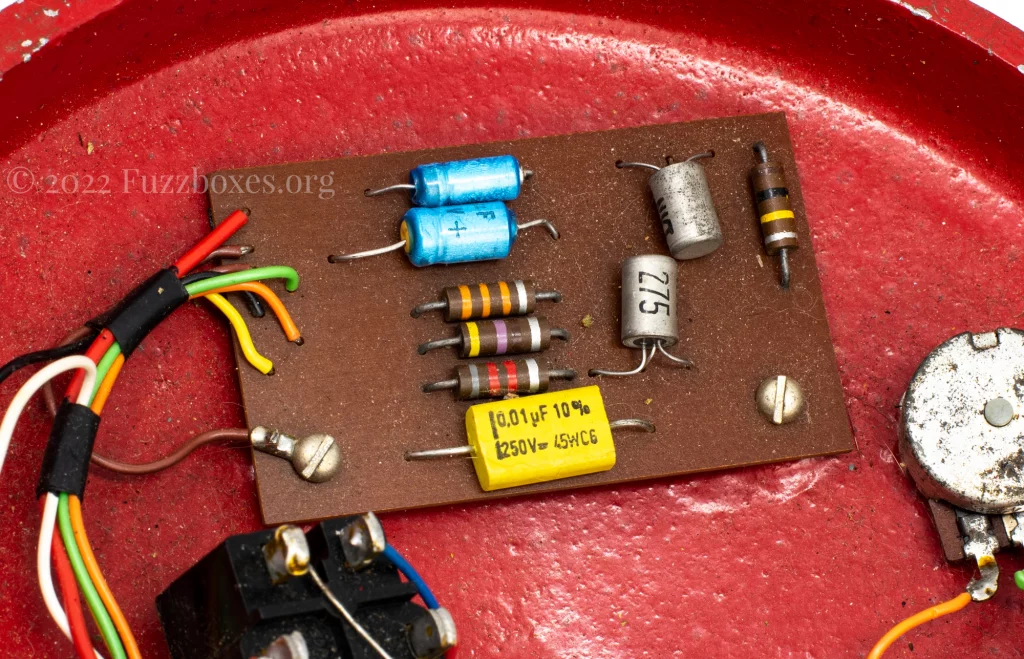
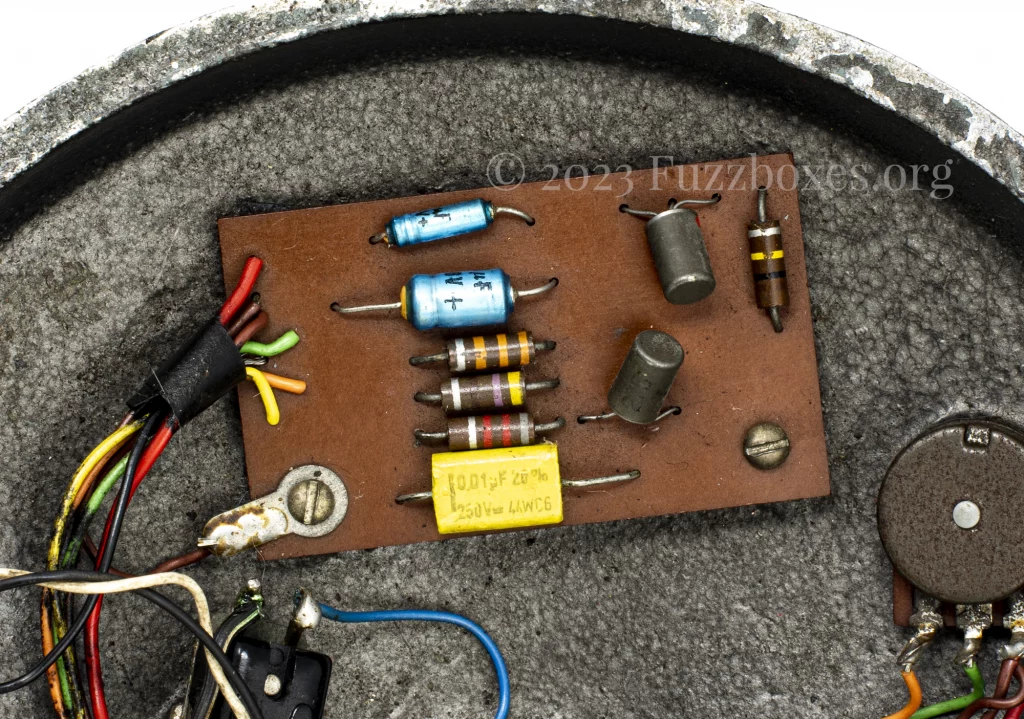
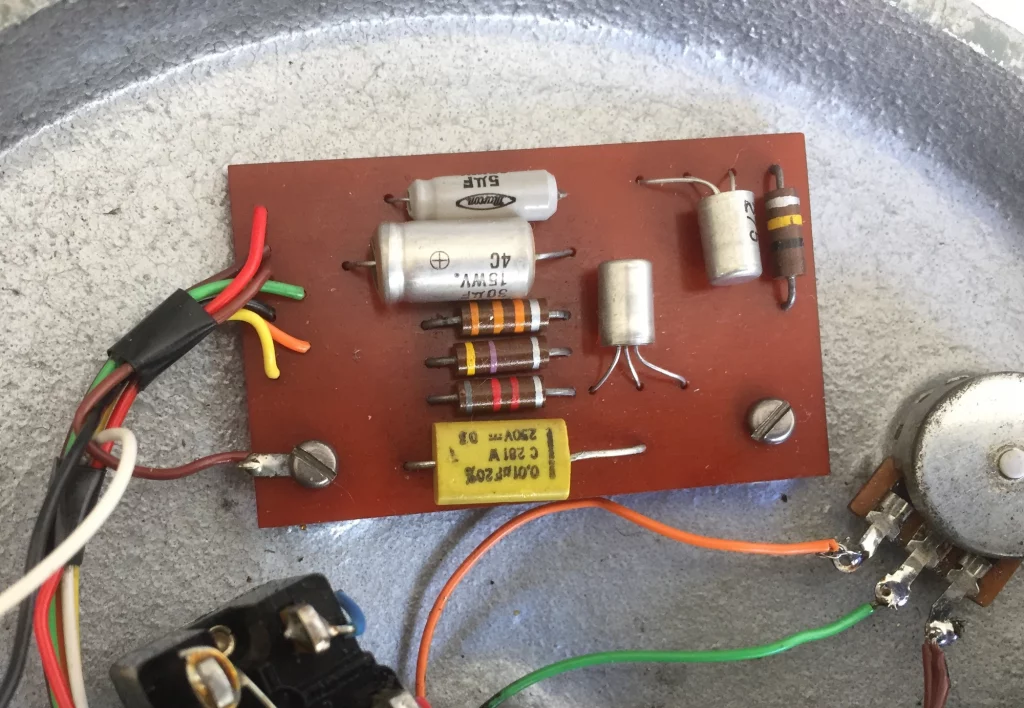
That being said, there were still at least three slightly different iterations of the germanium Fuzz Face circuit being built during the early period of 1966-1969. The first circuit board pictured above features the most commonly-seen mixture of parts for a germanium Fuzz Face — notably, the two blue axial capacitors for blocking DC at the input, and the Q2 emitter bypass cap, reading 2.5µF and 20µF respectively.
The second image above is of what was apparently a short-lived version of the germanium Fuzz Face. The only difference being the 2.5µF input capacitor being replaced with a 1.6µF capacitor instead. There is no known explanation for why the smaller capacitor might have been used, but it may have contributed to a very slightly brighter fuzz sound. Germanium transistor Fuzz Faces built towards the end of the run (c. 1968-1969) reverted to using the conventional 2.5µF input cap, and as did the silicon transistor Fuzz Faces that followed through the 1970s.
Image #3 is of a more unusual version of the early Fuzz Face. The white/grey axial capacitors are made by Marcon, and the input and emitter bypass caps read 5µF and 30µF, respectively. The larger capacitors may contribute ever so slightly to a thicker and darker sound, but what makes the 5µF input cap particularly interesting is that it is the same value that was used for the input caps in the earlier Tone Bender ‘MK1.5’ that Arbiter based their own fuzz box on.
Below is a schematic and accompanying chart, which illustrates the similarities and differences between several different versions of the Fuzz Face and Tone Bender ‘MK1.5’, to give a clear idea of the relationship between Arbiter’s and Sola Sound’s products.
1968-1969 | NKT275
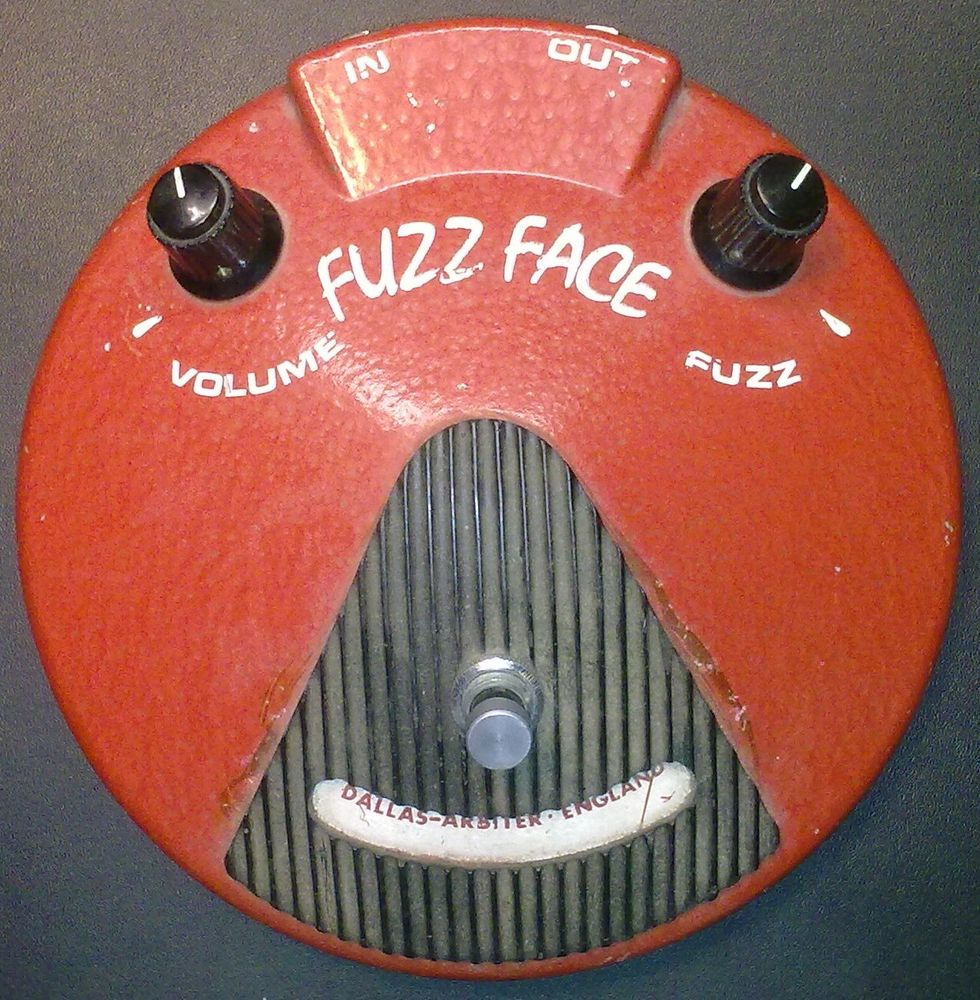
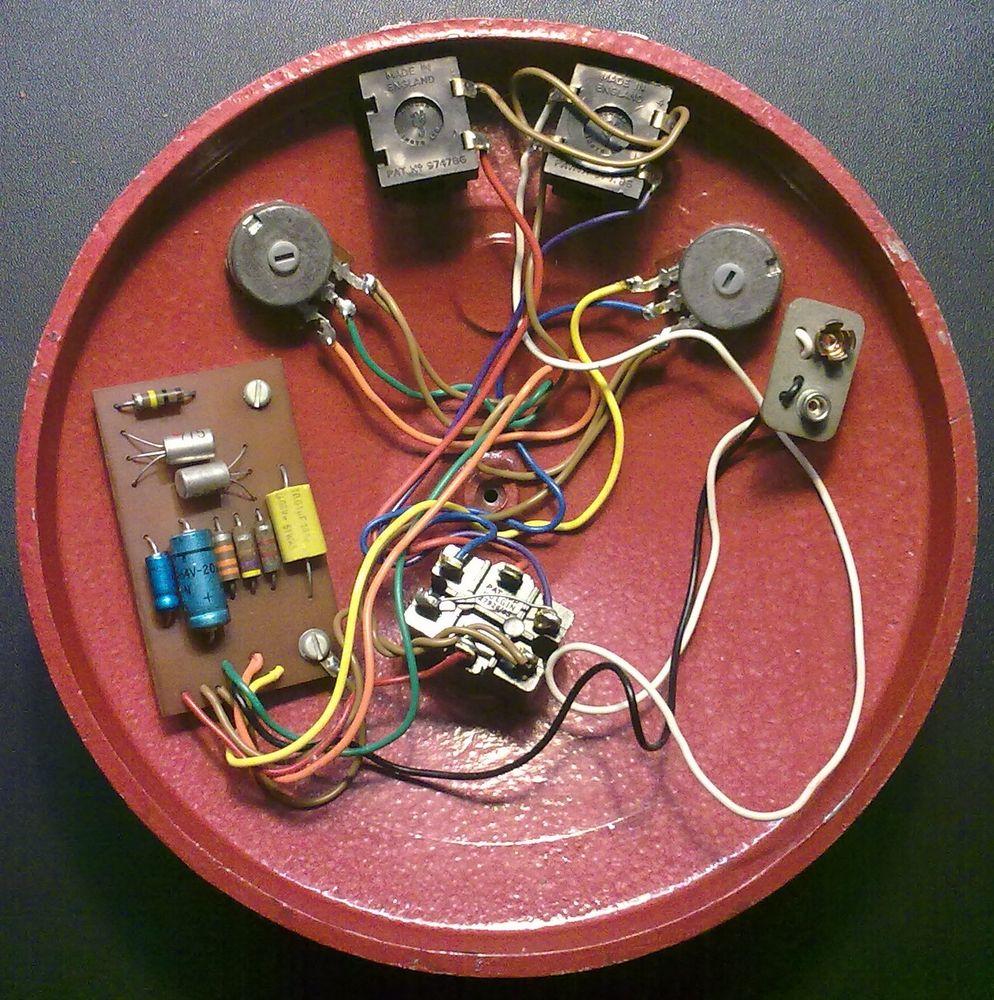
By the time that Arbiter’s cast aluminium enclosures were updated in 1968, the company was still building germanium transistor Fuzz Face circuits. Date codes on the pots of the Fuzz Face pictured above prove that production of the germanium Fuzz Face even continued into 1969.
These late-production germanium Fuzz Faces have only ever been sighted with what is often deemed the ‘conventional’ NKT275 circuit, with the blue axial 2.5µF input cap. Due to how Arbiter acquired 1966-dated pots in very large quantities, and apparently only resupplied in 1968, it isn’t uncommon to find 1966 date codes inside these later Fuzz Faces.
Interestingly, the same enclosures used for these later germanium Fuzz Faces were also used for some of the earliest silicon transistor Fuzz Faces. There is a strong likelihood that germanium Fuzz Faces were actually built in conjunction with silicon Fuzz Faces for a brief period around 1968-1969.
Silicon transistors
1968-1969 | BC183L, BC183KA
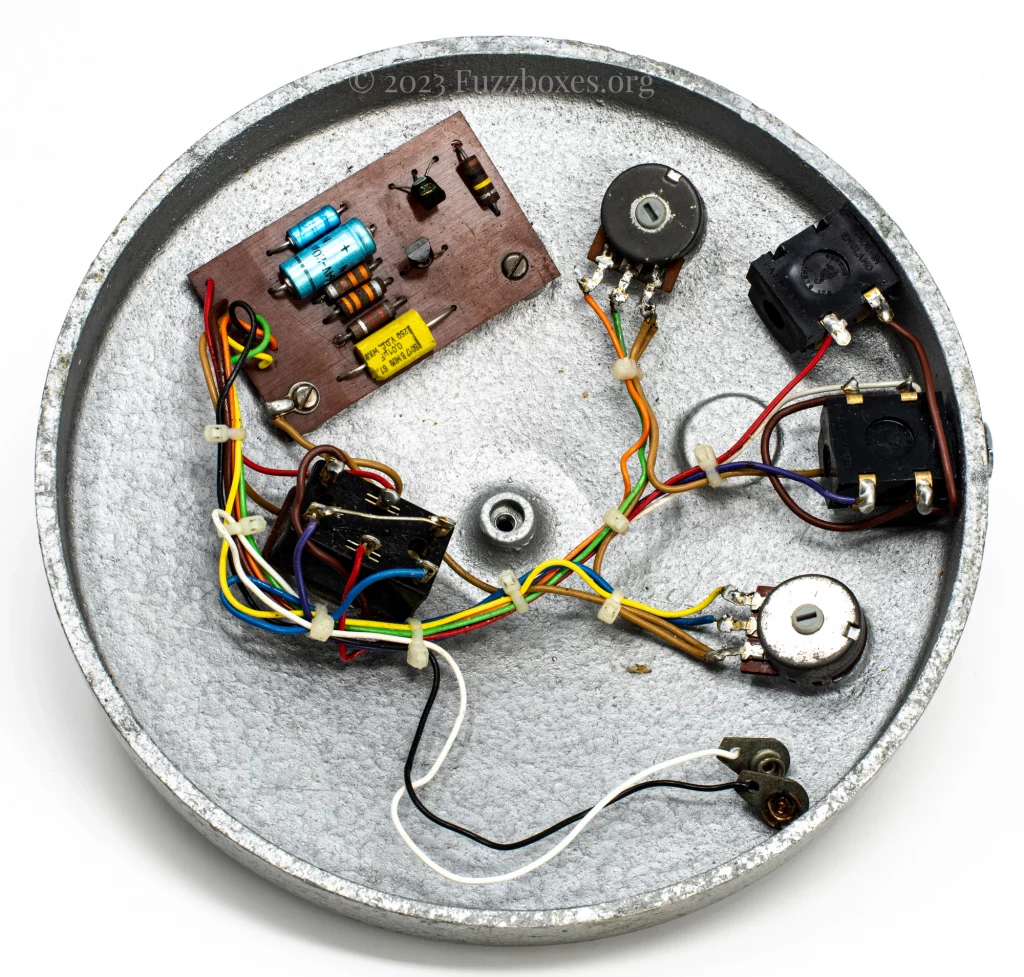
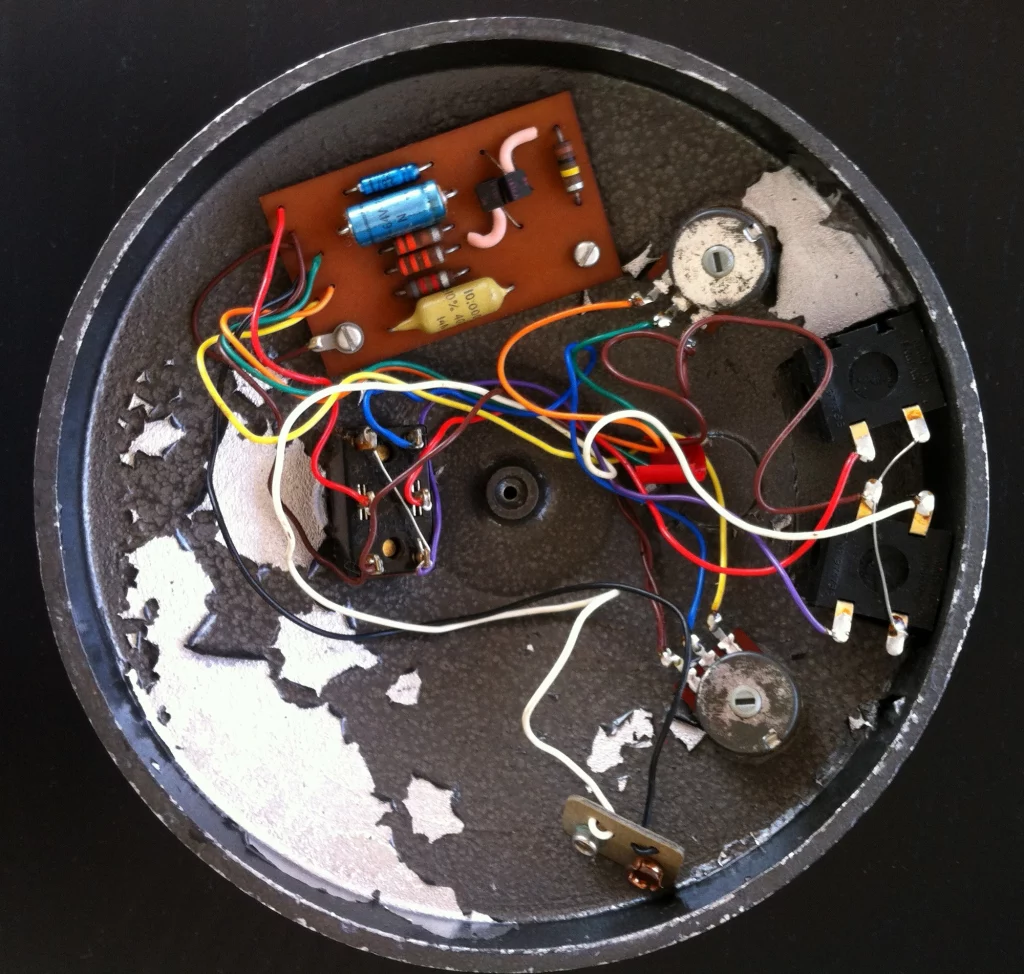
Towards the end of the 1960s, Arbiter’s Fuzz Face was redesigned, slightly, in order to accommodate NPN silicon transistors instead of the germanium NKT275 types. A selection of earlier silicon Fuzz Faces is pictured above. The very earliest type used BC183L transistors, and was housed in a ‘second version’ Dallas-Arbiter enclosure. These pedals typically come with pots dated October 1968. The BC183L circuit was also built into ‘third version’ enclosures, often featuring April 1969 date codes.
By mid-1969, at the earliest, Dallas-Arbiter moved onto using BC183KA transistors in the Fuzz Face. These circuit boards are easily differentiated from the BC183L boards due to the pink insulation on the transistor bases, as well as the yellow mustard capacitor used in the output position, instead of the rectangular chicklets on other versions of Fuzz Faces. BC183KA Fuzz Faces typically have pot codes dating to April and May 1969, and these circuits have been sighted in ‘third’ and ‘fourth’ version enclosures.
As mentioned previously, there is also a good possibility that Dallas-Arbiter were still building the last of the germanium Fuzz Faces alongside these earliest silicon ones. There is, however, no original (unmodified) silicon transistor Fuzz Face known to exist that was built prior to the Dallas-Arbiter merge.
1970s | BC108C, BC130C, BC239C, BC209C
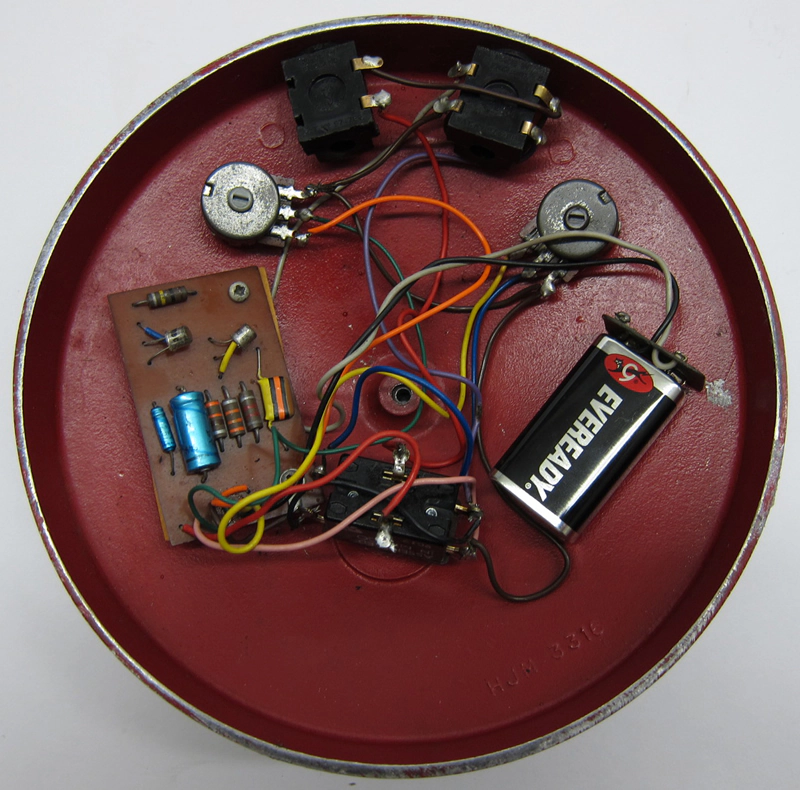
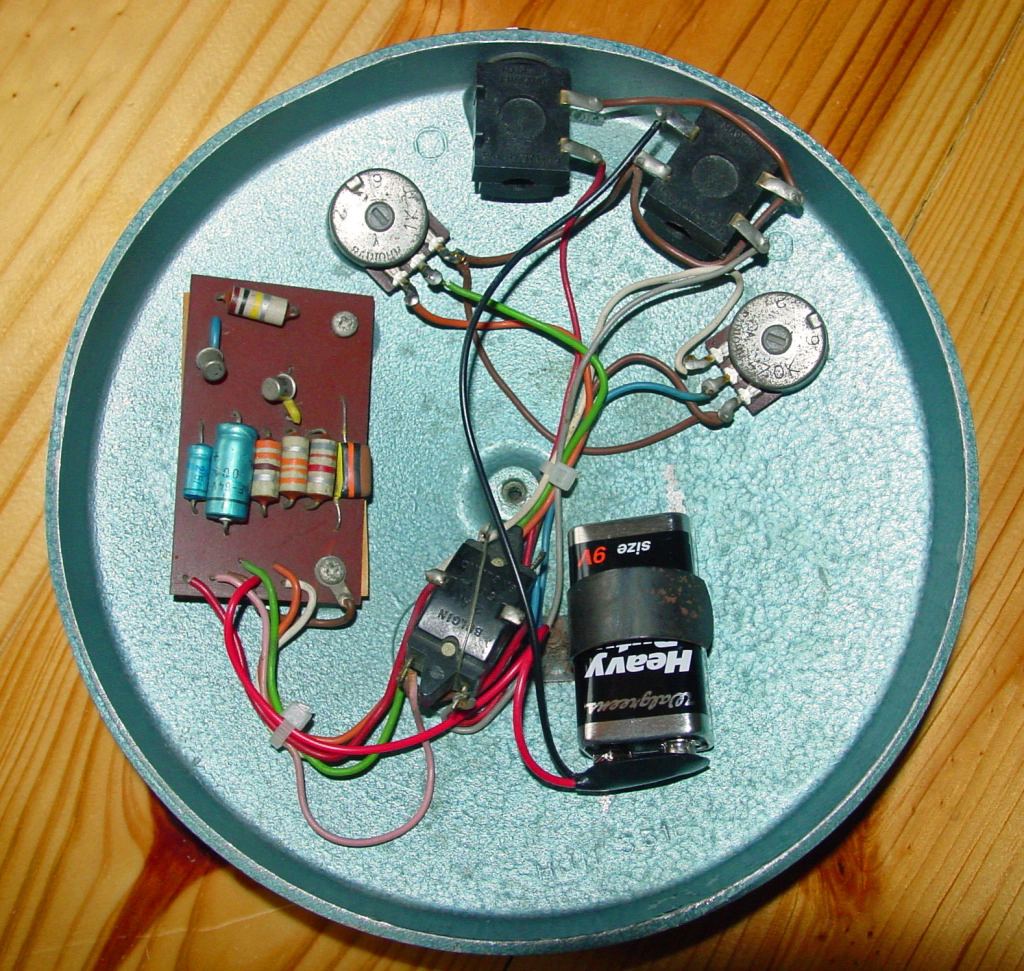
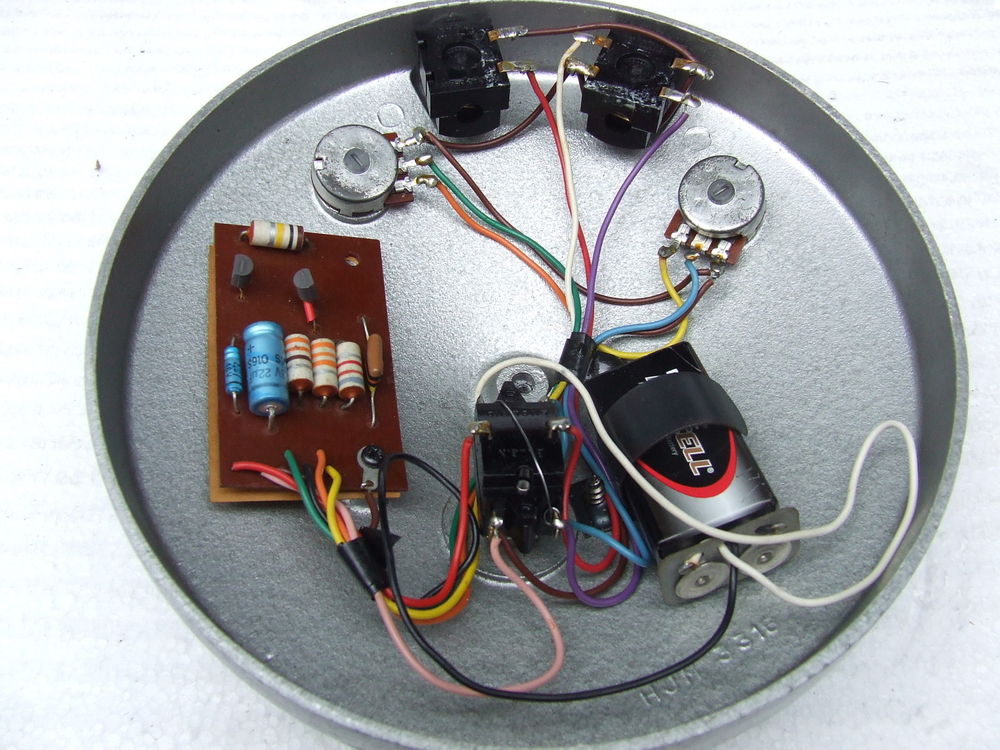
Following the BC183L and BC183KA Fuzz Faces, towards the end of the 1960s (or possibly even by 1970) Dallas-Arbiter started using BC108C transistors. BC108C Fuzz Faces almost always appear in ‘fourth version’ enclosures, although for reasons unknown, they occasionally also appear in the much earlier ‘second version’ Dallas-Arbiter housing.
BC130C transistors were occasionally used around the same time, and in some very unusual pedals, circuit boards appear to have been populated with a combination of both BC108C and BC130C devices. Fuzz Faces built further on into the 1970s sometimes used BC209C and BC239C transistors.
The exact chronology of these different silicon Fuzz Faces is very murky, and the selection of resistors and capacitors used by Dallas-Arbiter during the 1970s varied by enough to justify writing a separate analysis entirely about 1970s-era Fuzz Faces. Additionally, like the earlier germanium pedals, it is very possible that different versions may have been built in conjunction for a period of time.
Different enclosures
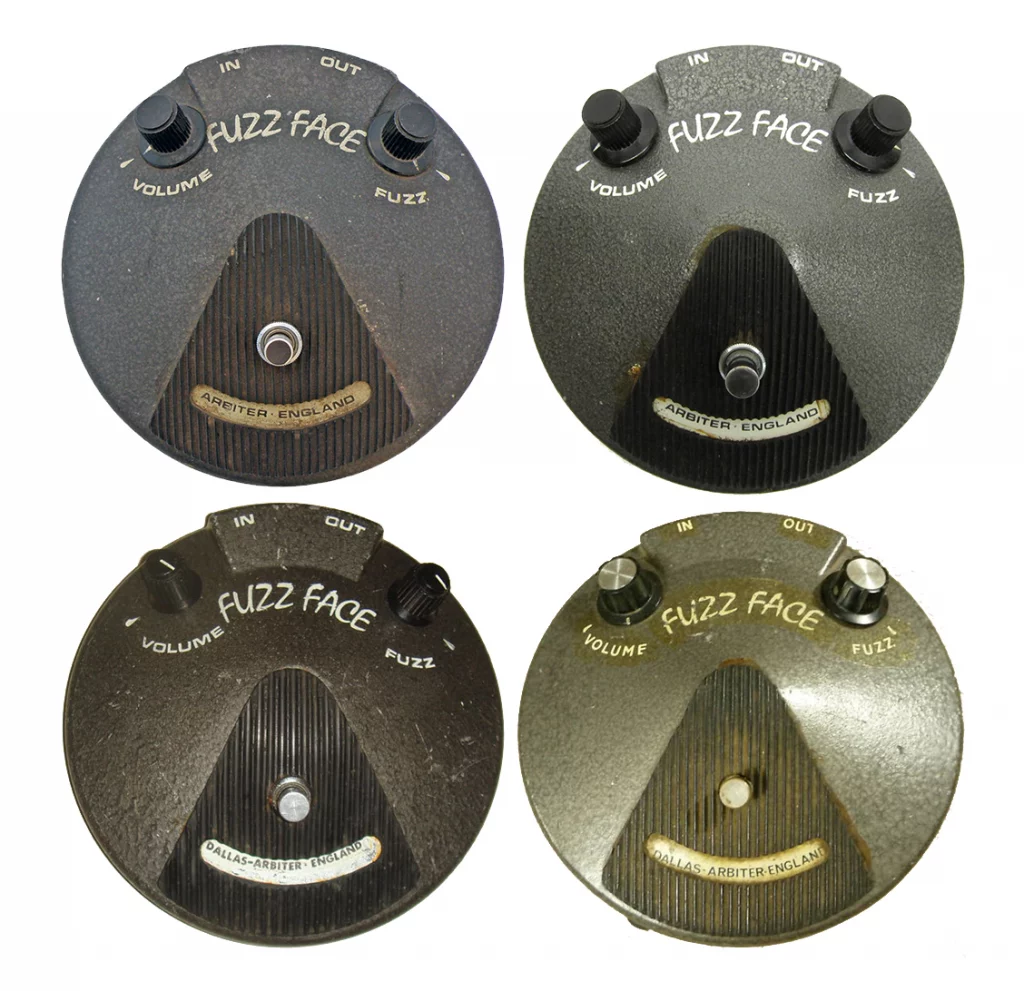
The famous round enclosures that housed Fuzz Face (as well as Treble and Bass and Trem Face) pedals were made out of cast aluminium. It isn’t known whether Arbiter subcontracted a third party to manufacture these enclosures, or whether the company developed an in-house casting facility. Either way, this would prove to be an efficient and economical way to mass-produce Fuzz Faces from the very beginning.
Over the course of the decade that Fuzz Faces were being built, the casting process changed a few times. New moulds were created to replace old ones, and in total there were four different versions of the Fuzz Face enclosure, all with slightly different shapes and proportions. The composite photo above shows examples of all four versions. Comparing the differences between each of the four enclosure styles helps with the the estimation of a pedal’s date of production.
1966-1967 | Version 1
The pedal pictured top-left has been built into what is known as the first version enclosure. These early Fuzz Faces have a noticeably ‘chunkier’ feel to them, compared with later versions. A simple identifier is the wider ‘brow’ of the pedal (where the input and output sockets are labelled), in combination with a higher ‘Fuzz Face’ logo placement, and only ever the pre-Dallas ‘Arbiter — England’ smile. Fuzz Faces in this first version enclosure were built around the period of 1966-1967, and only ever with the germanium transistor circuit. Some Arbiter Treble and Bass Face pedals were also housed in these early enclosures.
1968-1969 | Version 2
To its right is a slightly younger Fuzz Face. Without close inspection of these later Fuzz Face enclosures, it can be difficult to differentiate them from the 1966-1967 model. This is because the placement of the screen printed graphics remained the same as on the earlier enclosures. The main difference to look out for is the way that the raised ‘brow’ for the jack sockets at the top of the pedal, between the controls, is narrower than on the earlier Fuzz Face. Date codes on the pots in these second enclosure style Fuzz Faces indicate a period of production around 1968-1969.
Some Fuzz Faces built into these enclosures were branded ‘Arbiter — England’, like the 1966-1967 version, but the majority are branded for ‘Dallas-Arbiter — England’, following the two companies’ merge in Spring 1968. What this means is that any vintage Fuzz Face pedal housed in this ‘second’ type of enclosure, regardless of any date codes on the pots inside, is unlikely to have been built prior to 1968.
1968-1969 | Version 3
Bottom left is a third enclosure type, which most likely also made its appearance in 1968. The ‘brow’ for the jack sockets is considerably narrower than any of the other enclosure designs, and it extends further down towards the centre of the pedal. This resulted in Arbiter having to update the Fuzz Face graphics, and position the Fuzz Face logo further down as well. Date codes in these ‘narrow brow’ Fuzz Faces confirm that they were built around the period of late 1968 to 1969.
Something interesting to note is that, while these ‘narrow brow’ Fuzz Faces were all branded ‘Dallas-Arbiter’ (and were therefore clearly built post-merge), the Treble and Bass Face pedals that were also housed in these ‘narrow brow’ enclosures were branded ‘Arbiter’, similar to the 1966-1967 pedals. This suggests that these third version enclosures may have initially been intended for Treble and Bass Faces.
1969-1976 | Version 4
Finally, Dallas-Arbiter redesigned the enclosure once again to something that looks closer to the very first Fuzz Face design. The pedal, pictured bottom-right, has a wider ‘brow’ once again, but it has the same text placement as the ‘narrow brow’ enclosures that preceded it. Dallas-Arbiter clearly didn’t see a point in revising the graphics again.
The first of the ‘fourth version’ enclosures came with the same screen printed graphics as the ‘narrow brow’ pedals, but at some point in the early 1970s, Dallas-Arbiter began using decals to transfer the graphics instead.
Date codes on the pots of Fuzz Faces in this enclosure prove that this version wasn’t being built prior to 1969, and that Dallas-Arbiter would continue building Fuzz Faces into this type of enclosure until production in the UK ceased in 1976. The enclosure that Dunlop has been using for reissue Fuzz Faces since the 1990s is based off this fourth type of vintage enclosure.
Graphics
The four pedals pictured in the previous section all have the same typeface for the ‘Fuzz Face’ logo, and this is also the same logo that is still being used on the modern Dunlop reissue Fuzz Faces. Some of the earliest vintage Fuzz Faces came printed with a heavier version of the ‘Fuzz Face’ font, as well as a slightly wider kerning for the control and jack socket labels.
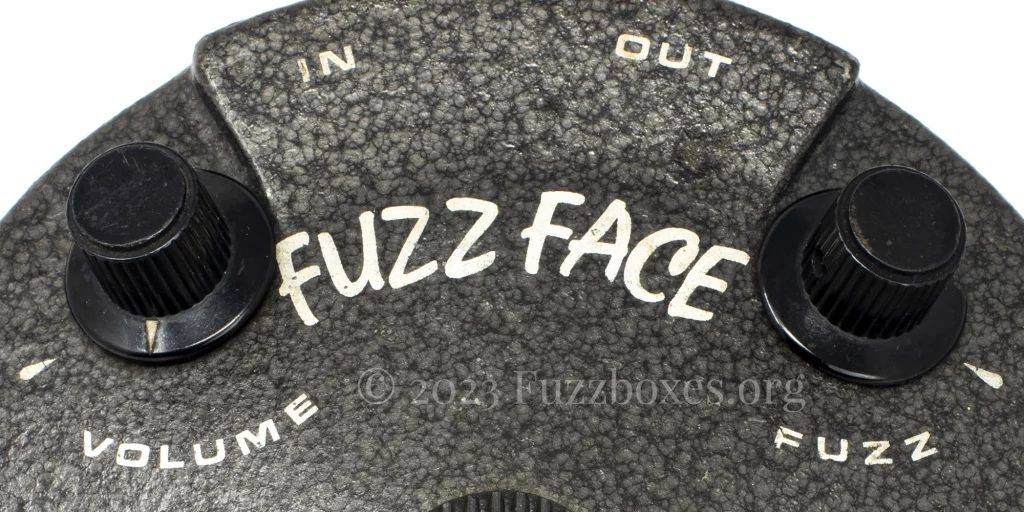
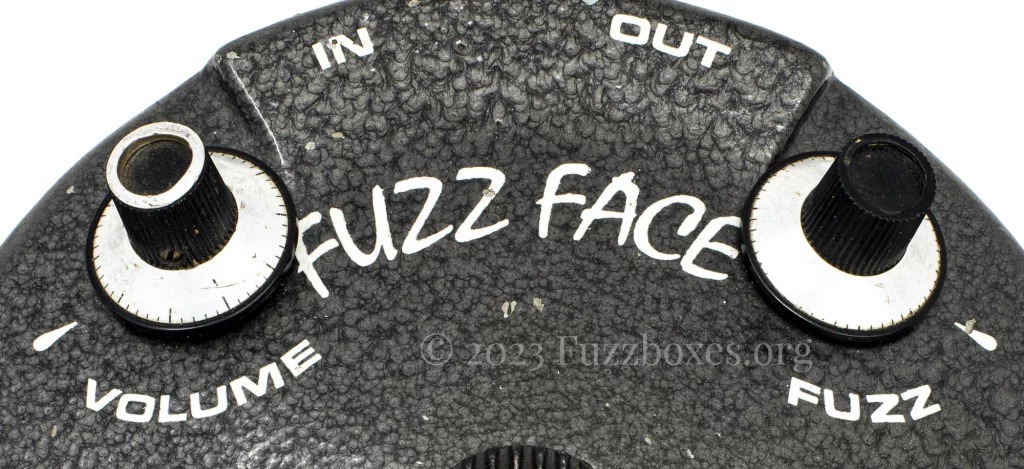
The set of graphics printed on the pedal above with the black ‘top hat’ knobs was only used for some of the Fuzz Faces in the first version enclosure. This detail has lead collectors in modern times to believe that pedals with this ‘thick’ logo are among the very first Fuzz Faces that were built in 1966. It’s true that, of the two typefaces pictured here, it was the ‘thinner’ variant that Arbiter continued using on their subsequent Fuzz Faces through the late 1960s. It may seem intuitive that the ‘thick’ print must therefore predate the ‘thin’ print, however, we cannot rule out the strong possibility that the different designs may have been built alongside one another for a period of time. After all, Arbiter was mass-producing Fuzz Faces from the onset, and pedals with the so-called ‘early’ (thick) logo often feature potentiometers with December 1966 date codes. This is a strong indicator that at least some of these ‘thick print’ Fuzz Faces weren’t built until 1967.
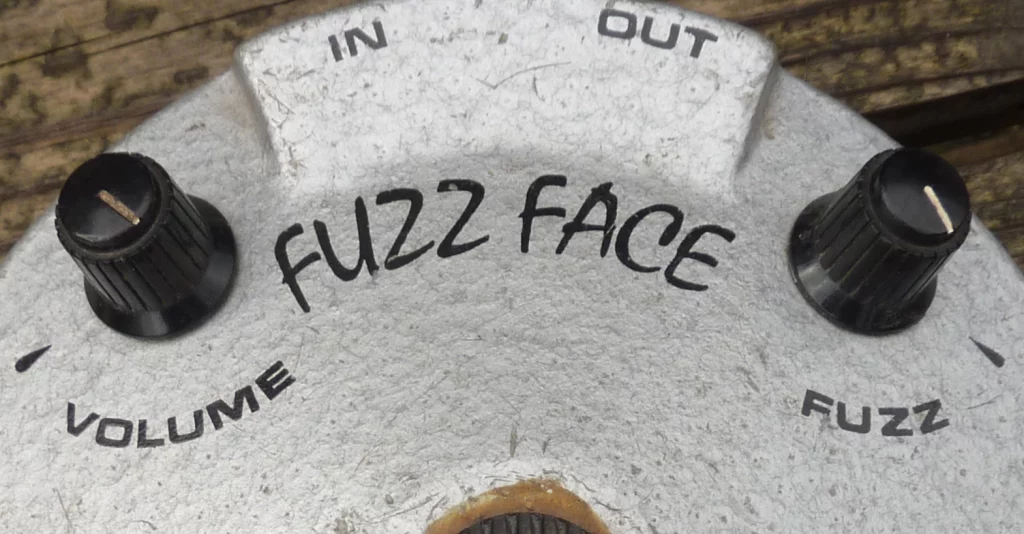
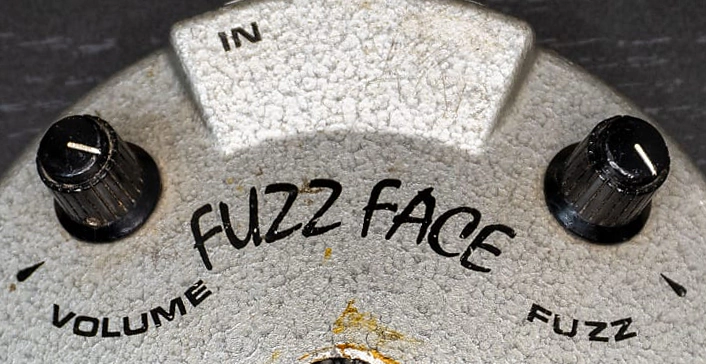
As mentioned previously, Arbiter didn’t make any changes to the silkscreened graphics once they moved over to housing Fuzz Faces in the second version enclosure. Once Arbiter moved over to housing Fuzz Faces in the third version enclosure (with the ‘narrow’ brow), the placement of the Fuzz Face logo was lowered in order to fit it onto the casting’s different shape. This reworked version of the original silkscreened graphics continued being printed on the fourth Fuzz Face enclosure type, which was introduced somewhere around 1969-1970, and was being made until the mid-1970s.
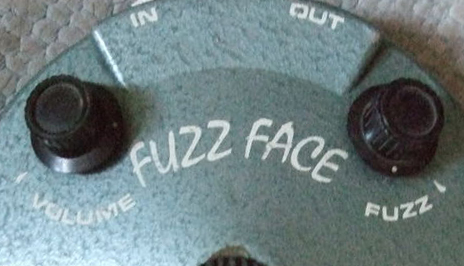
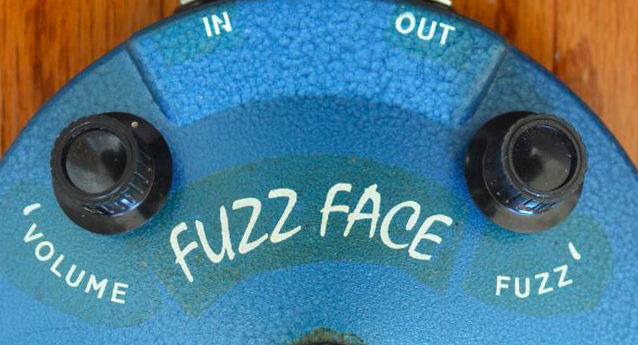
The most notable change to the graphics on Arbiter’s Fuzz Faces came about somewhere around 1971-1972, when the process of printing with silkscreens was replaced with transferring text to the casings from decals. The two pedals pictured above were both made in the early 1970s (according to their potentiometer date codes), however the pedal on the left has silkscreened graphics, whereas the one on the right has the visible outline around the text from where the decal was placed. Because the last of the silkscreened Fuzz Faces sometimes come with 1970 date codes on the parts inside, we can be certain that pedals with the ‘decal’ graphics weren’t built until the 1970s.
Knobs
Pictured above are the three types of knobs that were used for the Arbiter and Dallas-Arbiter Fuzz Faces, during the 1960s. The sort of knob fitted to a vintage Fuzz Face can often be a good indicator of the specific version of the Fuzz Face circuit has been built inside. Inversely, the different types of knobs that Arbiter used for their 1960s-era Fuzz Faces also correlate with parts selection and the different versions of the graphics printed to the casings, so we can use technical clues from a Fuzz Face to select vintage-correct replacement knobs when the originals have been lost.
1) Bulgin ‘top hat’ knobs
This black skirted knob was manufactured by Bulgin, and is one of the more common sorts of knobs fitted to Fuzz Faces. These knobs (sometimes known affectionately as ‘top hats’) were used on Fuzz Faces as early as in 1966, when Jimi Hendrix was photographed performing in Germany with a black Fuzz Face equipped with them.24 These knobs appeared exclusively on germanium transistor Fuzz Faces (including during the period around 1968 when the company appeared to make germanium and the earliest silicon Fuzz Faces simultaneously).
The germanium transistor circuit of the Fuzz Face was discontinued in place of the various silicon transistor circuits at some point around 1969, however, the Bulgin ‘top hat’ knobs made a brief reappearance in around 1970, when Dallas-Arbiter fitted them to Fuzz Faces housed in the ‘fourth version’ enclosure.
Some of the later germanium Fuzz Faces, built around the period of late 1968 to 1969, came with Bulgin ‘top hats’ that had an attractive additional silver disc fitted to them. In some cases, the adhesive used for these silver tops apparently hasn’t stood the test of time, and the pedal above reveals that without the silver disc attached, the ‘top hat’ is exactly the same as the conventional type.
Interestingly, there is a near-perfect correlation between Arbiter’s use of the Bulgin ‘top hat’ knob, and the Bulgin footswitch with the sealed plastic inner mechanism. In other words, a vintage Fuzz Face that comes equipped with the Bulgin ‘top hat’ knobs will almost certainly also come with the sealed Bulgin footswitch. This correlation appears with the earliest Fuzz Faces, around 1966-1967, but can be still observed in the early 1970s, until (Dallas-)Arbiter switched over to different knobs and switches.
2) Sato ‘dial’ knobs
These ‘dial’ knobs were made by the Sato Parts Co., Ltd., in Japan, and they were also used on some of the earliest Fuzz Faces during the period of 1966-1968 (as well as Arbiter’s Treble and Bass Face pedals).
The very earliest known image of a Fuzz Face pedal was featured on Arbiter’s early advertising in 1966. This pedal has some very obvious cosmetic differences compared with actual vintage 1966-1967 Fuzz Faces, which gives us reason to speculate whether it might have just been a prototype or a mock-up. It is nonetheless interesting to note that even this very earliest Arbiter pedal is equipped with the Sato ‘dial’ knobs.
The earliest set of known date codes in Fuzz Faces (July 1966) have also thus far only been observed stamped to potentiometers in pedals with the ‘dial’ knobs. Arbiter Fuzz Faces fitted at the factory with ‘dial’ knobs thus far also have a perfect correlation with the use of Bulgin footswitches with ‘wafer’ style mechanisms (as opposed to the more commonly-seen sealed black plastic mechanism). These ‘dial’ knobs have also only ever been sighted on Fuzz Faces with the ‘thin’ version of the graphics, built into the ‘first’ and ‘second’ enclosure types.
A later photo of the Arbiter Fuzz Face with ‘dial’ knobs began appearing in Arbiter’s advertising in 1967,25 and pedals with the same knobs are visible in a photo of the Arbiter booth at the BMII trade fair held in August of that year.26
3) 1968-1969 thin knobs
The manufacturer of these knobs isn’t known, but they are fairly common to find on Dallas-Arbiter Fuzz Faces built during the late 1960s.
The very first Fuzz Faces that have been sighted with these knobs have potentiometers stamped with October 1968 date codes, and it’s interesting to note that the use of these thin black plastic knobs happens to correlate perfectly with the introduction of the BC183L silicon transistor circuit. When the BC183L circuit was revised with BC183KA transistors in 1969, Arbiter continued to use these thinner knobs for the silicon Fuzz Faces. Meanwhile, the germanium Fuzz Faces from that period still came with Bulgin ‘top hats’ described at the beginning of this section.
The earliest silicon Fuzz Faces (with BC183L and BC183KA transistors) appear to have been built alongside the last of the germanium units, and as a result, they all came housed in identical (‘second’ and ‘third’ version) enclosures. Determining whether the pedals have these thinner knobs, or whether they have the Bulgin ‘top hat’ knobs, is a relatively safe way to differentiate between germanium and silicon Fuzz Faces without examining the electronics inside.
There are always anomalies, however, when it comes to analysing vintage Fuzz Faces, and the very last of the germanium Fuzz Faces (housed in the ‘third version’ enclosure, with pots dating to 1969) sometimes also came with these mysterious ‘thinner’ knobs.
1970s ‘Orange’ knobs

These round knobs started appearing on Fuzz Faces in the early 1970s, replacing the Bulgin ‘top hats’ on silicon transistor Fuzz Faces. The knobs might have been made by Schurter, and they’re very similar (if not identical) to the knobs that were famously also fitted to Orange amplifiers at the time.
Fuzz Faces with these later round knobs typically feature pots that are stamped with 1972 date codes, and so it’s a certainty that any Fuzz Face with these round ‘Orange’ style knobs wasn’t built prior to the 1970s.
Footswitches
Bulgin laminated “wafer” switch

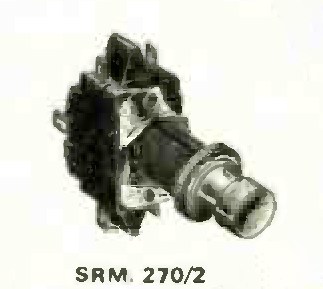
Some of the earliest Arbiter Fuzz Faces (c. 1966-1967) were fitted with a ‘wafer’ style double-pole/double-throw (DPDT) footswitch. Not to be confused with the very similar looking ‘wafer’ style DPDT switches made by Arrow (as used in Buzzarounds and early Sola Sound & Vox Tone Benders) — these switches were made by Bulgin.
Due to its appearance, this type of construction is known colloquially as a wafer. In Bulgin’s advertising, however, they are described as having a “laminated construction”. DPDT switches with the metal push-button were assigned the number ‘270’ in Bulgin’s catalogue, and the same identifier is debossed into the clasp holding the wafer together.
These laminated ‘wafer’ switches were only fitted to Fuzz Faces for a brief period during the mid-to-late 1960s. Interestingly, ‘wafer’ switches seem to appear almost exclusively on germanium Fuzz Faces with ‘thin’ print and the Sato ‘dial’ knobs.
Bulgin “moulded” switch
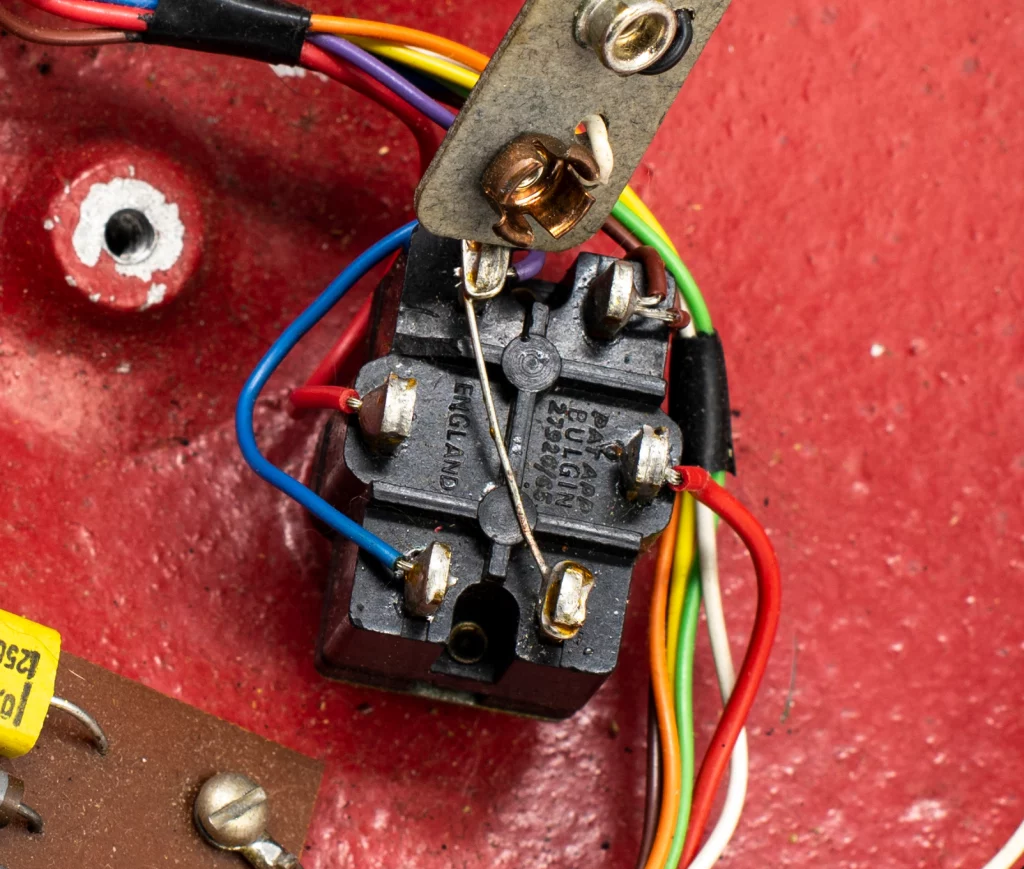
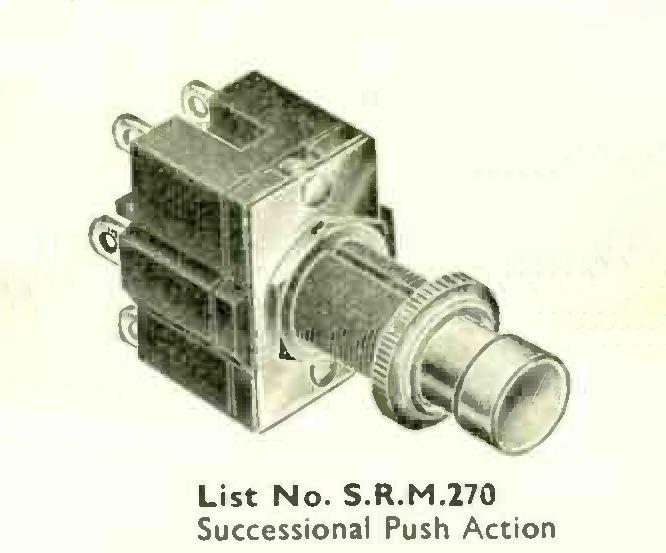
These Bulgin switches were virtually identical to the wafer model pictured previously. Other than the slightly different layout of the contacts, the main difference is that the inner mechanism of the switch has been sealed in what Bulgin described as a “polished black moulded body”. It isn’t known when Bulgin’s range of moulded switches were developed, but these apparently supplemented the existing range of laminated wafer switches. In 1969, Bulgin reported their intention for these moulded switches to ultimately replace the inferior wafer types.27
Bulgin DPDT switches with the moulded body were used on some of the earliest Fuzz Faces in the period around 1966-1967, including the rare variant with the 5μF/30μF electrolytic capacitors. Fuzz Faces printed with the ‘thick’ version of the graphics also appear to have been fitted exclusively with these switches.
Similar to how the Bulgin ‘wafer’ switches were used for pedals that happened to also feature Sato ‘dial’ knobs, Arbiter’s use of moulded switches correlates with the Bulgin ‘top hat’ knobs instead. This is an important observation when selecting suitable replacement parts for vintage pedals. For example, a vintage 1966-1967 Fuzz Face that is missing its knobs, but retains an original moulded Bulgin switch, can be fitted with replacement ‘top hat’ knobs in order to be historically accurate.
As well as on early Fuzz Faces, these Bulgin moulded footswitches can be sighted on some ‘version 4’ Fuzz Faces, built around the early 1970s
Arrow switches
For reasons unknown, Dallas-Arbiter went through a period of using Arrow DPDT footswitches instead of the usual Bulgin type. These switches were functionally the same as the Bulgins, although the Arrows generally seem to have stood the test of time because it’s actually quite unusual to find a Fuzz Face (or indeed any pedal) with a faulty Arrow switch, compared with the rather unreliable Bulgins.
The earliest sighting of an Arrow footswitch in a Fuzz Face is the ‘version 2’ Dallas-Arbiter model, and specifically, the BC183L version. Arrows remained in use for BC183L, BC183KA and NKT275 Fuzz Faces until around 1969-1970, when Dallas-Arbiter returned to using moulded Bulgins again. Confusingly, some very late NKT275 Fuzz Faces (c. 1969) still came with the moulded Bulgin switches.
1970s Bulgin switches
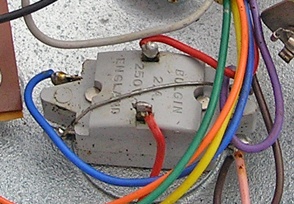
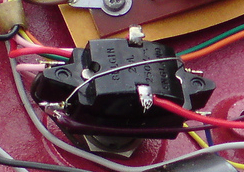
Dallas-Arbiter continued using Bulgin DPDT footswitches through the 1970s, until production of the Fuzz Face in the UK ceased around 1976. Two later versions of Bulgin switches are pictured above, and it is very safe to say that any vintage Fuzz Face that was fitted with one of those from the factory wasn’t built prior to the 1970s.
Share your fuzz!
I welcome any comments, feedback, queries & corrections in relation to the Fuzzboxes.org project. Please get in touch via this contact form (or on the ‘contact‘ page).
Much of our understanding of the development of 1960s fuzz boxes comes from analysis of surviving pedals themselves, and so photos of pedals belonging to readers are particularly useful in furthering this research.
If you would like to contribute pictures of 1960s-era guitar effects to Fuzzboxes.org, then feel free to send in any pictures via the uploader below. Photos are greatly appreciated, and any submissions are not published on this website without advance agreement with the contributor.
Extra special thanks to Electric Warrior/J. Voggenthaler for diligently saving and sharing photos of vintage Fuzz Faces for the last 15 years
- https://web.archive.org/web/20150722123731/https://www.independent.co.uk/news/obituaries/ivor-arbiter-314771.html
- Record Mirror, 21st March 1964, p. 7
- International Musician & Recording World, March 1975, p. 61
- Beat Instrumental, April 1965, p. 31
- Beat Instrumental, April 1965, p. 31
- International Musician & Recording World, March 1975, p. 61
- Melody Maker, January 19th 1957, p. 12
- Melody Maker, June 15th 1957, p. 14
- Record Mirror, 21st March 1964, p. 7
- International Musician & Recording World, April 1975, p. 33
- Record Mirror, 21st March 1964, p. 5
- Tape Recorder, September 1967, p. 357
- Melody Maker, 8th August 1966, p. 8
- Ulrich Handl, 8th November 1966, The Jimi Hendrix Experience, Big Apple, Munich, [https://ulrichhandl.com/produkt/jimi-hendrix/]
- Music Trades, November 1966, p. 87
- Melody Maker, 20th April 1968, p. 4
- International Musician & Recording World, May 1975, p. 40
- International Musician & Recording World, May 1975, p. 40
- International Musician & Recording World, May 1975, p. 43
- https://web.archive.org/web/20240220225349/https://stompboxes.co.uk/forum/viewtopic.php?p=129550#p129550
- https://www.musicradar.com/news/the-history-of-the-fuzz-face
- https://web.archive.org/web/20160910102944/https://www.foxroxelectronics.com/The-Fuzz-Face-Reissue-Story_b_3.html
- Melody Maker, 20th April 1968, p. 4
- Ulrich Handl, 8th November 1966, The Jimi Hendrix Experience, Big Apple, Munich, [https://ulrichhandl.com/produkt/jimi-hendrix/]
- Melody Maker, June 3rd 1967, p. 3
- Music Trades, September 1967, p. 60
- Wireless World, November 1969, p. 545
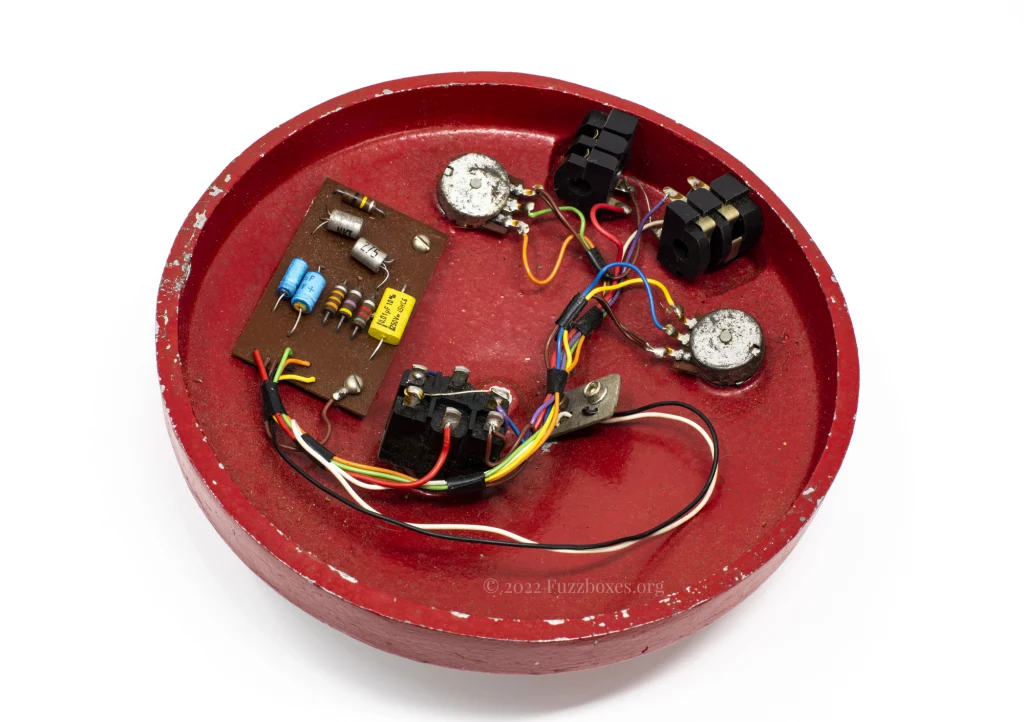
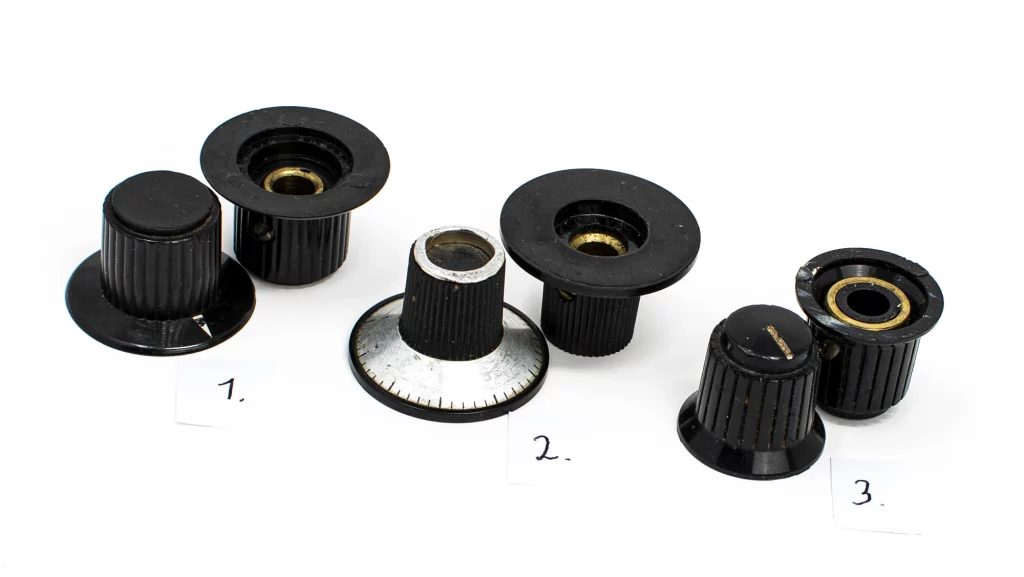
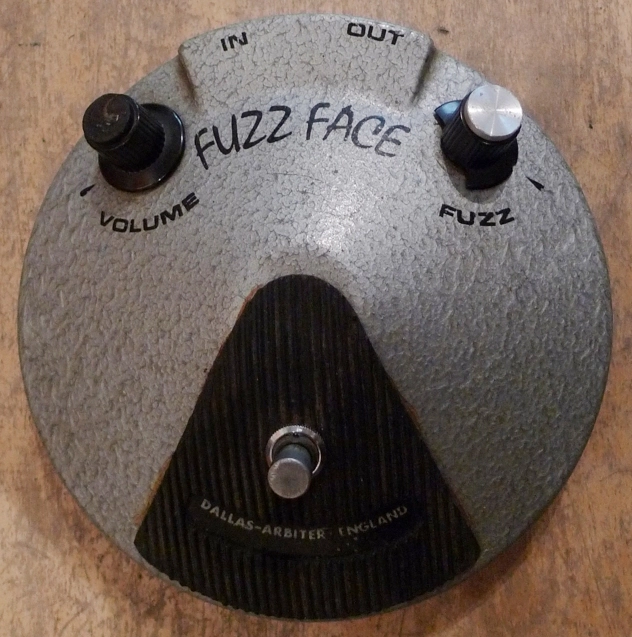
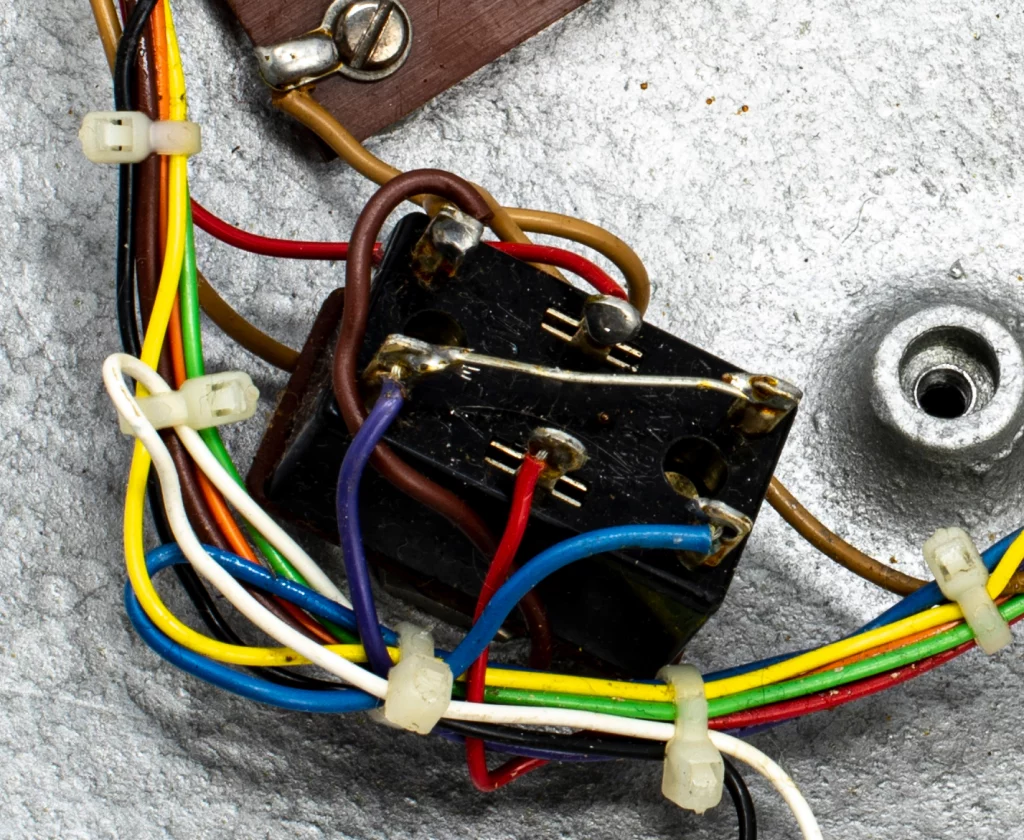

Great info, I have a 90’s Arbiter FF that has been tampered with by swapping out the AC128s for old NKT275s, the fuzz pot is shot and no matter how much contact cleaner I hit it with it won’t stop scratching, the volume pot is ok but I want to get new pots, is there a recommended make of pot I should get or can I just put in ones with the correct values?, Thanks.
P.S it sounds incredible with the 275s!.
Omeg makes pots which are pretty good modern replacements for the old RadiOhm types typically found in vintage Fuzz Faces (including the last of the germanium pedals), so they’d certainly look right in your Arbiter reissue 🙂
Those two silver fuzz faces are mine, and that’s my photo.
They’re not identical — the one with the small hole in the front is an early germanium, the other one is a Si transistor with BC183Ls — see the later pic of mine you’ve branded with your website address. I odn’t know who J. Logan is or why they get photo credit for my photos of my pedals.
Hi,
The silver Fuzz Face with the hole was indeed one of yours (and before then, Electric Warrior’s), but the photo isn’t — J. Logan is the person you sold it to some years ago, and this is a photo he took and shared on Facebook last year. The other Fuzz Face in that photo is germanium as well, and if I didn’t know the internals of it already, then there are various visual clues that indicate it. BC183L Fuzz Faces come in a slightly different enclosure style from those particular two 1966-67 germanium units (which can be recognised by the size & shape of the ‘brow’). By the time DA was building BC183L Fuzz Faces, they had also settled on using the version of the graphics as on your old pedal with the hole in the face (compared with the thicker ‘Fuzz Face’ print, with wider kerning for the control & jack socket labels, on the second pedal in Logan’s photo). DA also tended to use a thinner style of control knob compared with the ‘top hat’ style Bulgin knobs.
The photo of the BC183L Fuzz Face circuit board on this page is one that I took of a pedal in my own collection.
Hey Dev-
Actually those are both my pedals and I took that picture. Those are both Arbiter FuzzFaces I have. I did get that one with the ‘Marilyn’ hole from you though.
Cheers!
I’ve got a blue one with BC108Cs. Any tips to narrow down the year even more? Looked for data stamps and the like but nothing is jumping out. Thanks!
They made Fuzz Faces with BC108C’s for quite a while during the 1970s. The earliest blue ones came with screen printed graphics, and they typically have 1969 pot codes. Later blue ones had slightly different graphics with several different types of decals instead, and those typically have 1972 pot codes. There are also some really late blue BC108C Fuzz Faces that are branded ‘Dallas Musical Industries’, which would date to around the mid-1970s (after Ivor Arbiter split from Dallas).
We can put the blue BC108C pedals into some sort of chronological order based on graphics and parts selection, but I don’t think DA restocked pots in 1970, 1971 or 1973 (or at least I haven’t seen any pictures of pedals with original pots bearing those codes), so it’s difficult to pin-point an exact year to specific examples. Feel free to email me some pics of your pedal and I’ll take a guess!